
Tuesday, September 17, 2024

After decompressing from flight snafus en route to Argentina with several enjoyable days exploring Buenos Aires with photographic guide Bernardo Galimari, today we were off to the wildlife side of Argentina, Peninsula Valdes and hopefully, southern Atlantic right whales (SRW), penguins and sea lions. Peninsula Valdes is a nature reserve and was designated a World Heritage Site in 1999.

Groupie at the entrance to Puerto Piramides, with Adriana (left) manning the camera, with me and Greg seated and cleaned up for a change.

SRW breach! What a splash they create after launching their massive bodies out of the water, sometimes repeatedly.
Our 2 hour afternoon flight south to Trelew left us enough time for a walk in the Botanical Garden, a few blocks away from the hotel. It is an oasis of lush greenery, with towering trees and luxuriant vines, punctuated with classical statuary.
Adriana (Basques, our leader and holder of the mandatory permit) and Hector Caisin (representing the Argentine government) welcomed us to Patagonia at the airport. Our two hour drive to Puerto Piramides was enhanced by the glow of the rising full moon,.
We had dinner at the hotel, El Paradiso, lamb stew for me and fish of the day for the others.
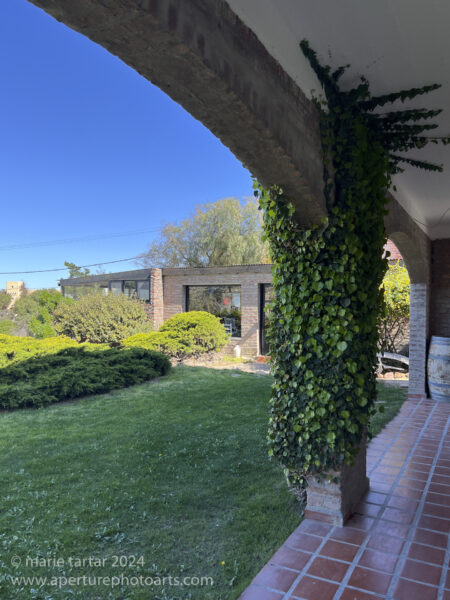
El Paradiso, our home in Puerto Piramides for this adventure, was comfortable enough, especially after a mobile heater was wheeled into my room (3) a few days in, after I realized the central heat wasn’t working.
Wednesday, September 18, 2024
Today was our first day on the water, Golfo Nuevo or New Gulf. The bulbous eastward projection of Peninsula Valdes forms a protected body of water in which SRWs can mate, give birth and nurture their calves. This year, a record number of 1468 SRWs were identified on the yearly survey. Sadly, 71 deaths were also recorded, including 18 adults and 53 calves.
Adriana (“not a morning person” ) generally prefers to head out at 10 am. The sun peeked intermittently through the clouds.
We immediately encounter a white “albino” baby whale, but with whale watching boats in the vicinity, we headed further out into the gulf.
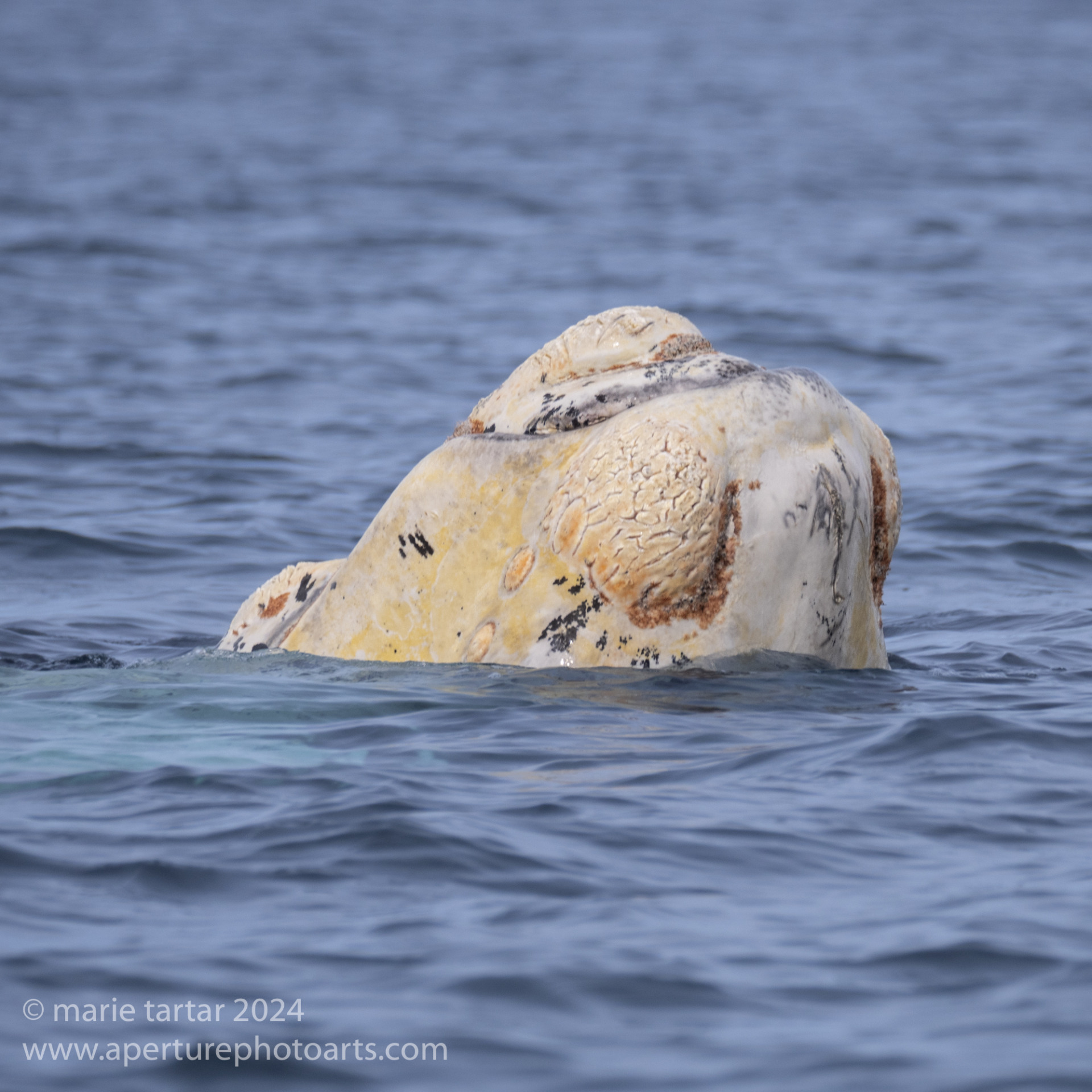
Rostrum of an “albino” SRW calf, sighted almost as soon as we were pushed by tractor into the water. Sadly, although there were a record number in this year’s count (3, vs. 1 the prior year), we never had an underwater encounter. White babies are not true albinos (completely lacking in pigmentation), but have a recessive genetic trait. They darken over time but often have lighter patches even as adults.
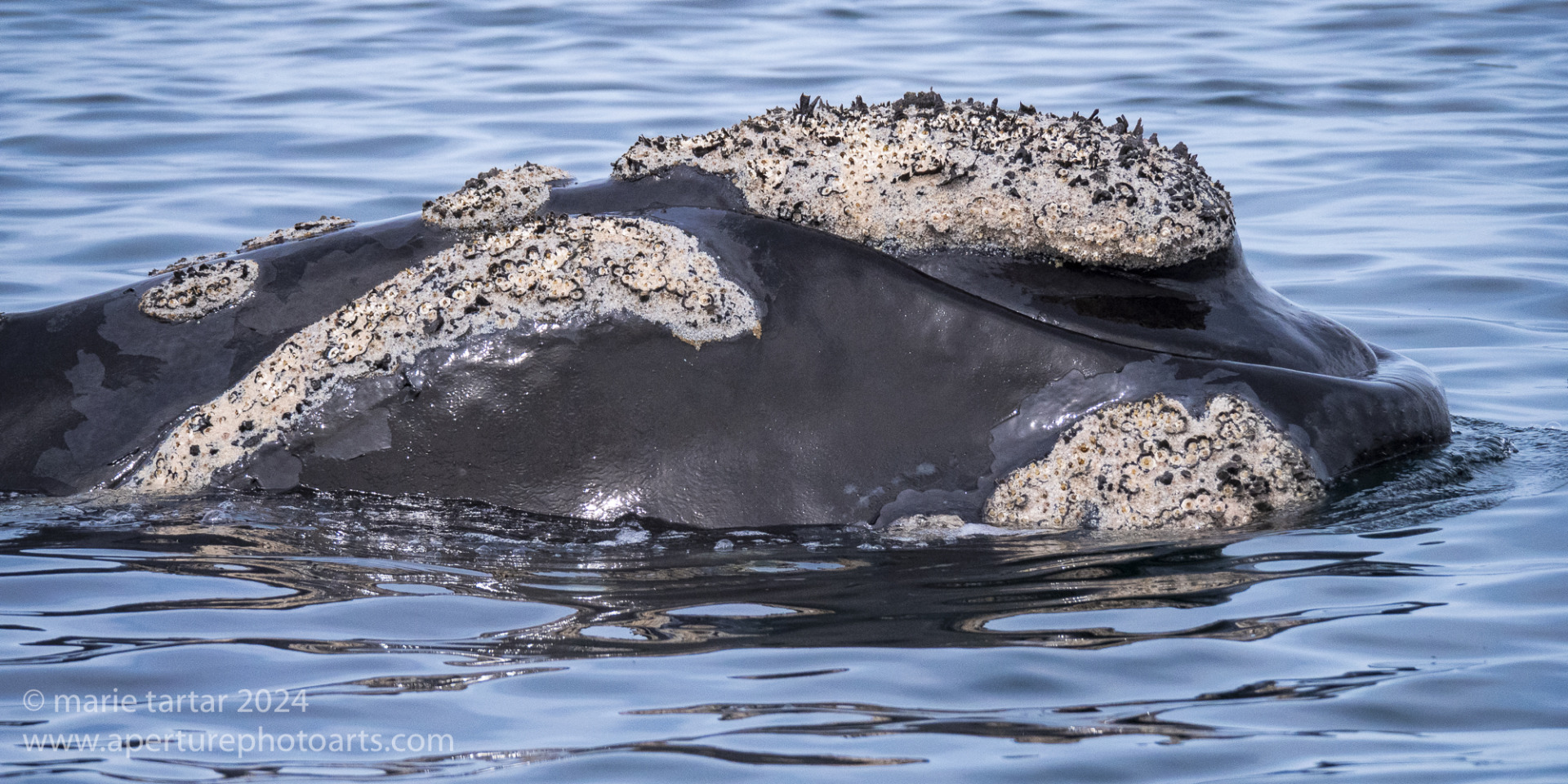
SRW have distinctive thickened callous-like rough tissue patches (callosities) by which they can be individually identified.
But first, we had a chance to photograph a local sea lion colony.
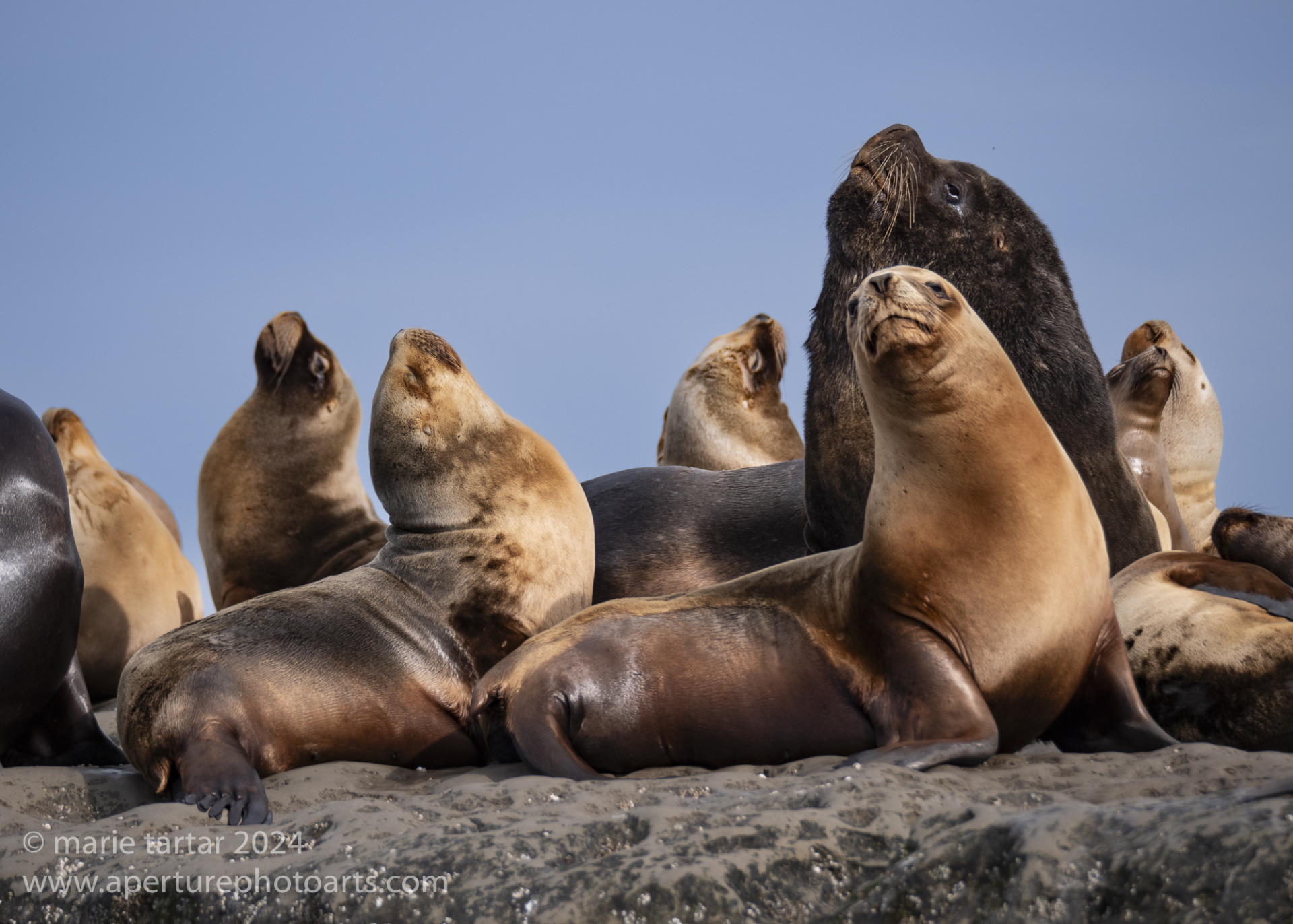
Southern sea lion colony, Puerto Piramides, Peninsula Valdes, Argentina. Notice how much larger the black male bull sea lion is than his harem of females.
Adriana accompanied us into the water for our first in-water forays, with Greg going first. His first ventures were a series of quick fly-bys. My first encounter was much closer-a whale practically under the boat, eye to eye, in touching distance. I was so buoyant in my brand new 7 mm Henderson wetsuit, it was tough to get my feet down and I was hard pressed to maneuver in the water. Adriana had instructed us to stay close together at all times and never to turn one’s back to the whale. These instructions sometimes worked at cross purposes as the whales frequently turn. The key evidently is to start backing up as soon as the eye passes, as the potentially dangerous tail swiftly follows and even a baby whale’s tail is enormous and capable of inflicting grave injury. We are at potential risk from a curious baby, with less control over their movements.
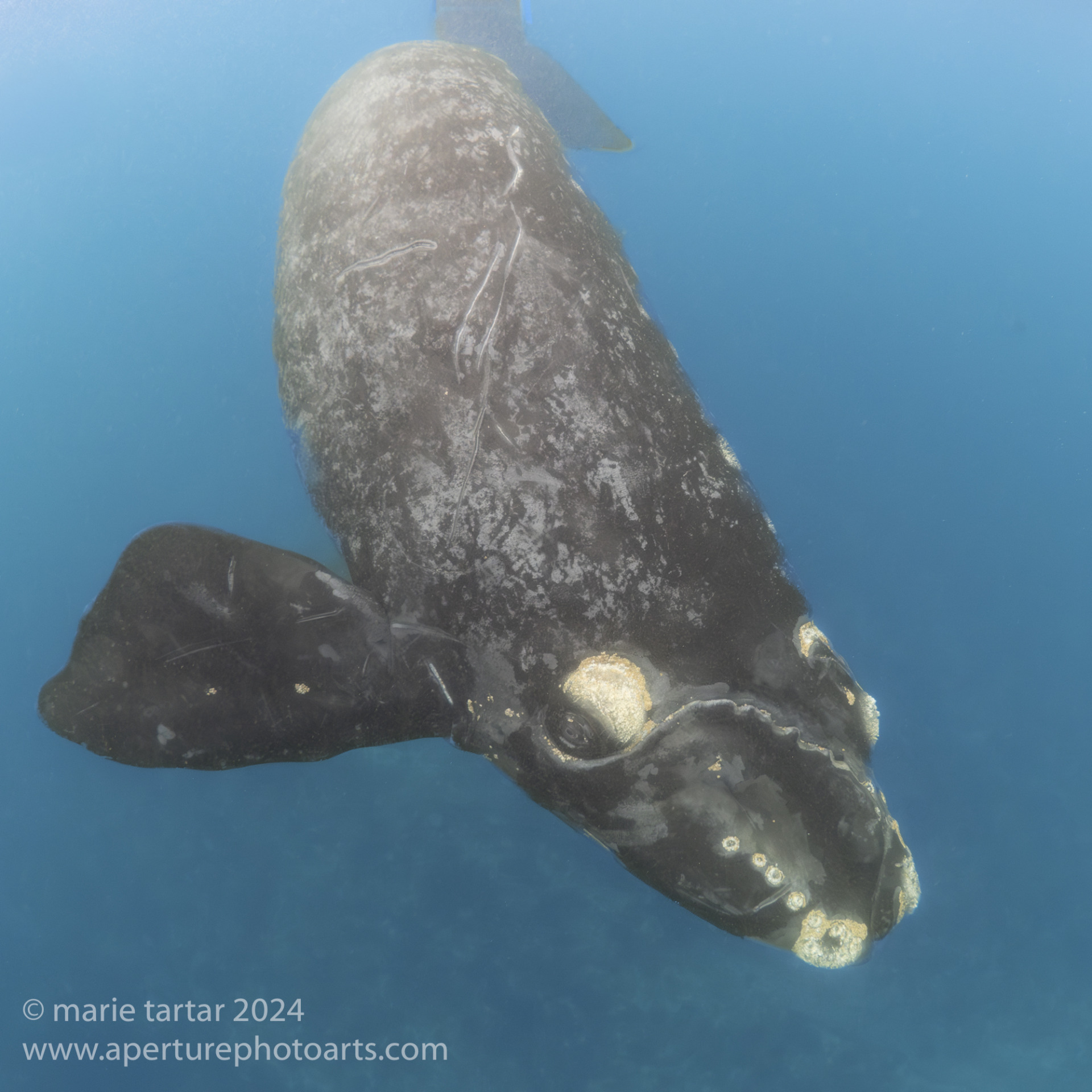
Southern right whales (SRW) have distinctive markings, by which individuals can be identified. Roughly mirroring the distribution of facial hair in humans, the SRW has whitish raised patches called callosities.
In the morning, I was pleasantly surprised that I was reasonably comfortable in my suit. It is a semi-dry, with double layers at the wrists and ankles and difficult to don, but its design limits the amount of water which enters. Conversely, since we are out on the boat all day without bathroom facilities, it means there is little alternative to peeing in the suit or holding it all day. By the end of the day, I was sore from straining against the suit, which is further filled out by a newly acquired heated vest, which has heating coils supplied by two bulky batteries which fit against my rib cages. Lifting my land camera up to shoot from the boat was strenuously resisted by the suit, even turning my head was an effort, constrained by a thick hood. To keep my hair dry, Adriana offered me a bathing cap (like women used to wear in pools in the 1950s) to wear under the hood. Greg and I were rendered virtually helpless by our double layer dry gloves, which Hector and Captain Jorge (“Pollo”) helped us don. For the first time in, Greg wore one with the latex seal applied against his skin, with the other layered between the wetsuit’s two wrist seals, quickly learning that the dry option requires the latex seal against the skin, the more difficult to arrange of the two possible positions. Once in these gloves, we are as helpless as children, although the warmth and manual dexterity offered for operating the camera is the offset.
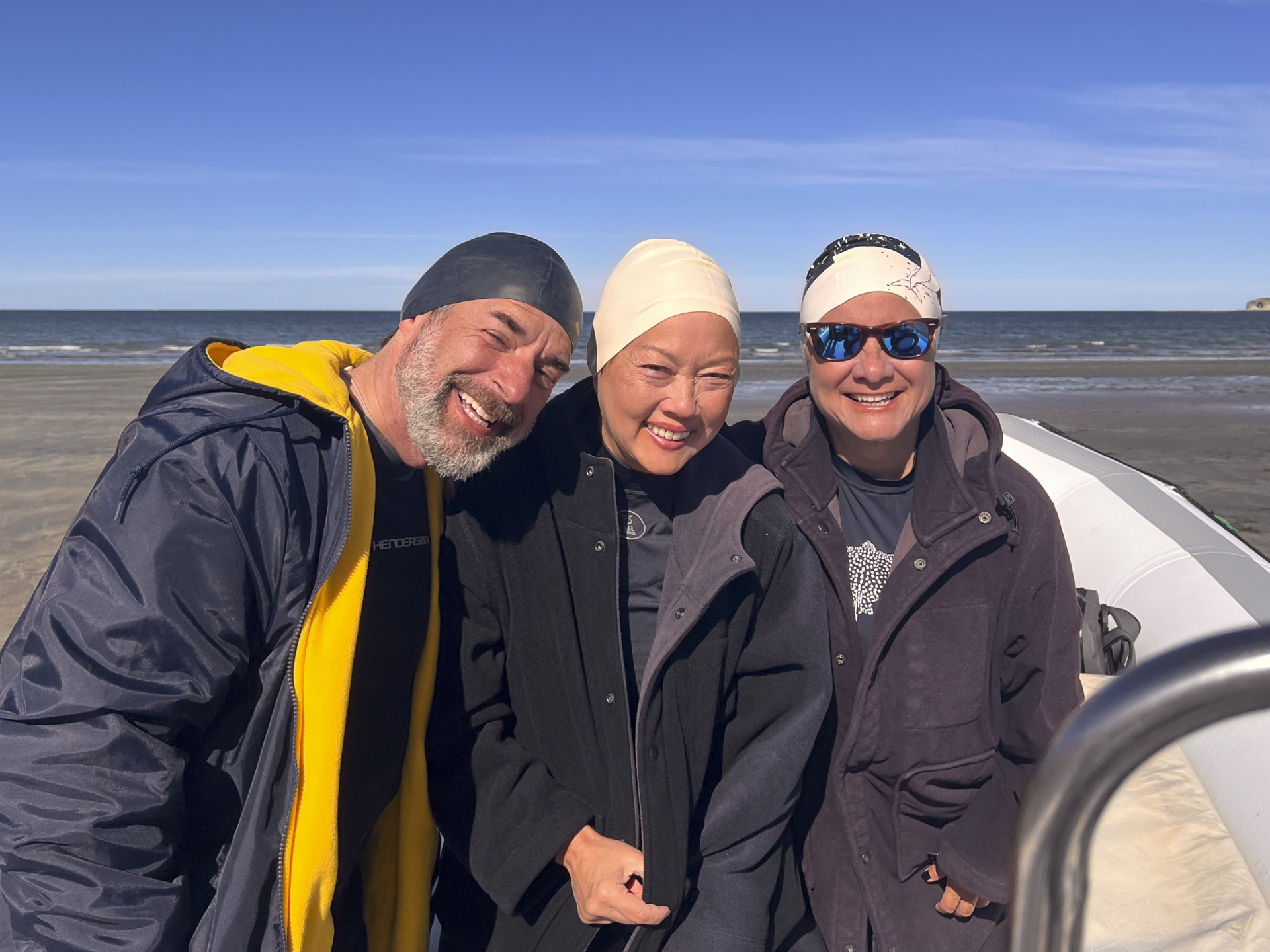
Pinheads! The uniform of the SRW photographer: bathing caps to try to keep one’s hair dry under a substantial neoprene hood (10 mm for me and Greg) and fleece Surf-fur parkas over 7 mm semi-dry wetsuits (me and Greg) and custom free-diving suit (Adriana).
The afternoon and the cold were a different story. Greg commented as he went in “The water feels colder now!” I had to agree, at least at first. By now, I was also wearing a weight belt, which added to my feeling of breathlessness. Later, when I was in the water without Adriana, I wore her ankle weights instead, which was much more comfortable. Maybe we felt the cold more because we were in the water longer. At one point, Adriana and I were blocked from returning to the boat by a SRW right next to the boat, so close that Hector, Captain Jorge and Greg on board the boat were taking selfies of themselves with whales in the background.

Can’t return to the boat, even if you are cold, if there is a whale blocking your way! This was our first day out. From left, Hector, Greg (blue gloves) and Captain Jorge “Pollo”, enjoy a very close encounter with a curious SRW. What looks like a fourth person between Hector and Greg is the Captain’s console, draped with his Surf Fur, the expedition uniform. I’ve owned one for years, but it is so bulky it has mostly stayed in my garage, but on this trip, I virtually lived in it.
In the morning , I had felt comfortable enough to switch on the heated vest only intermittently, just for a minute or two, at “1”, the lowest setting. But by the afternoon, both Greg and I were cranking up our vests to new heights, enough to run out of battery by the day’s end. The YouTube video I watched after purchasing the vest, featuring a burly dive shop owner reviewing the product, mentioned that neither he nor his divemasters ever felt the need for the maximal “3” setting in 40 degree water!.
Adriana contracts with a local woman (Laura, called Lala) to supply lunch boxes. Today’s contained two excellent corn quiches, large enough that most ate just one. The chocolate and oatmeal cookies which appeared later were scrumptious.
Dinner was at La Estacion, which was closed when we arrived the night before. Tonight, it was bustling with families. I enjoyed a giant steaming mound of large, head-on grilled shrimp, which required slippery finger work to extract. Greg and Hector went for pasta offerings. Adriana stayed back at the hotel with work needing her attention.
Thursday, September 19, 2024
We awoke to a drippy and gray Puerto PIramides, with wind and rain. Snails were ensconced on the restaurant door at breakfast. Our departure for the water was pushed back to midday at the earliest.

I have rarely seen as much whale imagery as adorns Puerto Piramides, a small town in Peninsula Valdes, Argentina.
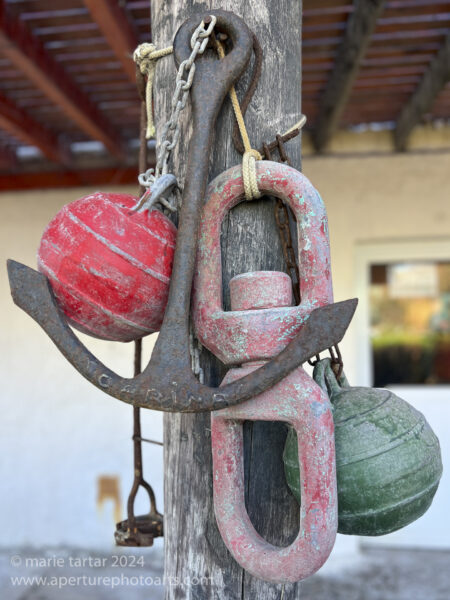
If it’s not whale imagery, it’s nautical artifacts (floats and an anchor adorn Quiqui’s dive shop in Puerto Piramides, Argentina).
Ultimately, instead of going out on the water, I met Hector and Greg at 3 pm for a hike from the hotel, down to the boat launch, up onto the cliffs backing the town, to the dunes behind and finally down to the low tide exposed beach to sea caves and algea encrusted rocks and back, almost 4 hours and 6.6 miles. It was sunny and crisp by then. I flew the drone from the ridge. When I was landing it, concentrating on hand catching it, Hector and Greg began exclaiming, watching a dog chase a rabbit on the perilous cliffs across from us.

Aerial view of the cliffs backing Puerto Piramides, the only town within the Peninsula Valdes nature reserve.
At dinner at La Covacha, I enjoyed a local specialty, arroz con mariscos.
Friday, September 20, 2024
Plans were formed, only to be rearranged hours later as the forecast for wind changed constantly. As we drove south to Doradillo, an armadillo crossed the road. I stalked a fox in the parking lot. Adriana calls Doradillo the “parade of whales”. Indeed, SRWs were sighted up and down, just off the beach, which was lined with bundled-up spectators.
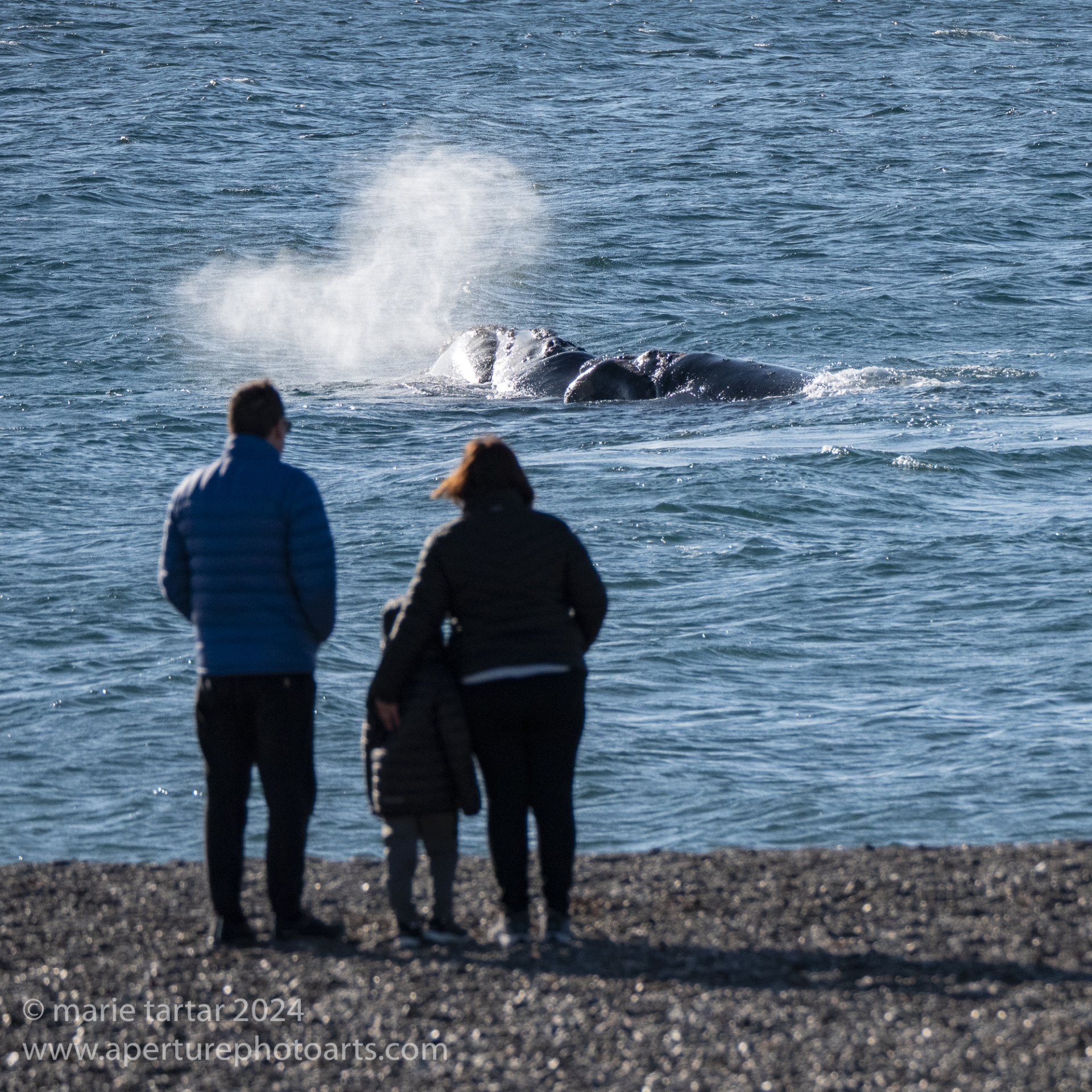
Whale watching usually means going out on a boat and seeing blows and if you are lucky, a back or a tale. In Peninsula Valdes at Doradillo, SRWs sweep up and down a stretch of ocean, just offshore of a long pebbly beach. The “V” shape of the SRW’s blow is clearly seen here.
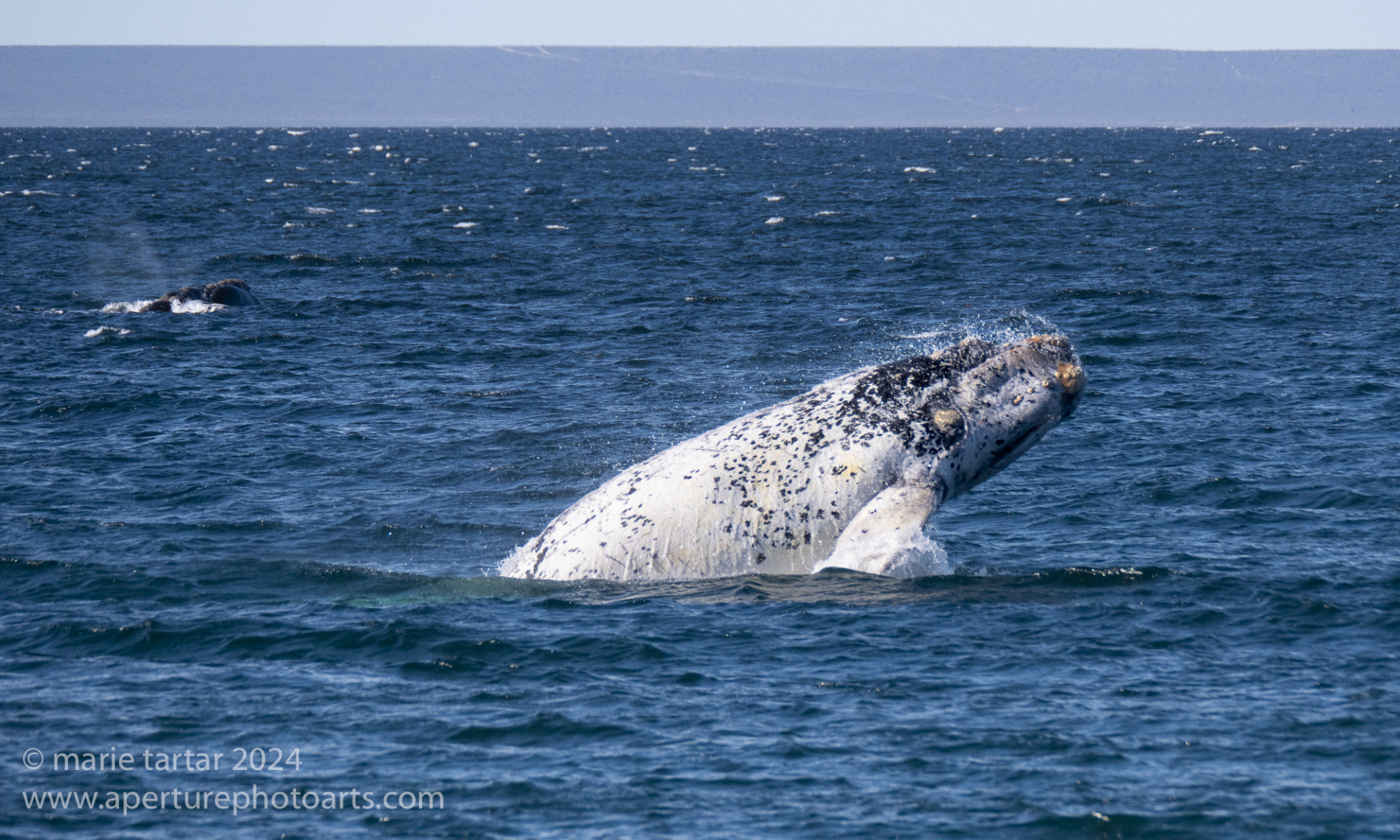
An “albino” baby launches itself out of the water, while another SRW blows further out from shore, just offshore at Doradillo, a beach outside Peninsula Valdes, north of Puerto Madryn.
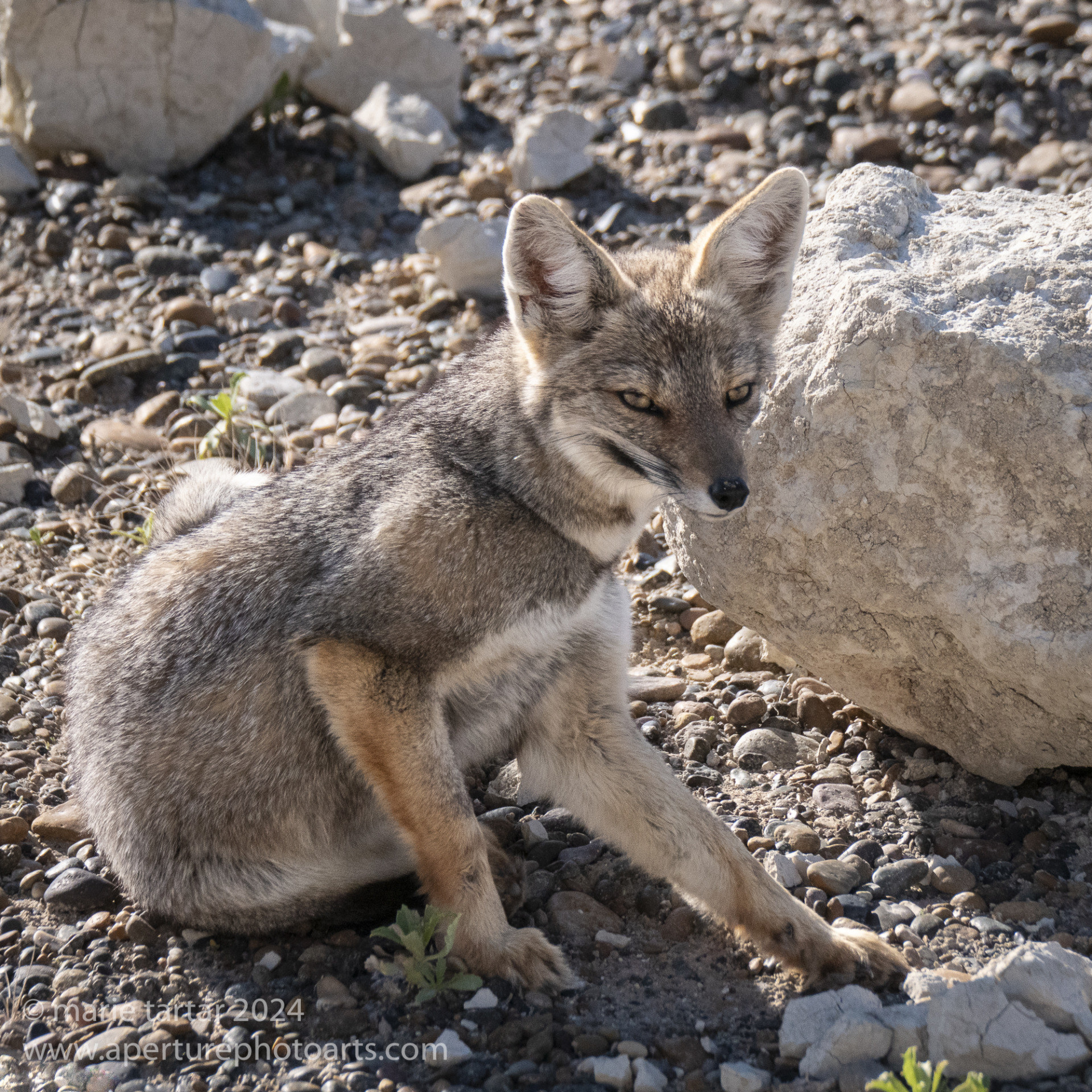
We spotted several foxes during our time in Peninsula Valdes. Adriana said we were lucky in this regard, although the prior group fared better with armadillo sightings.
Afterwards, we drove further south to Puerto Madryn. The resident flamingos were not too numerous, intensely pink or particularly close. We had lunch on the water and dinner back at the hotel.
Saturday, September 21, 2024
Conditions for going out on the water today were not too favorable, so we drove north to a Magellenic penguin colony. A large group of tourists was expected at 11 am, so we left early, in order to have the colony to ourselves for a while and to beat the group to lunch. On the drive, we spotted guanacos and a nesting pair of variable hawks (Geranoaetus polyosoma).
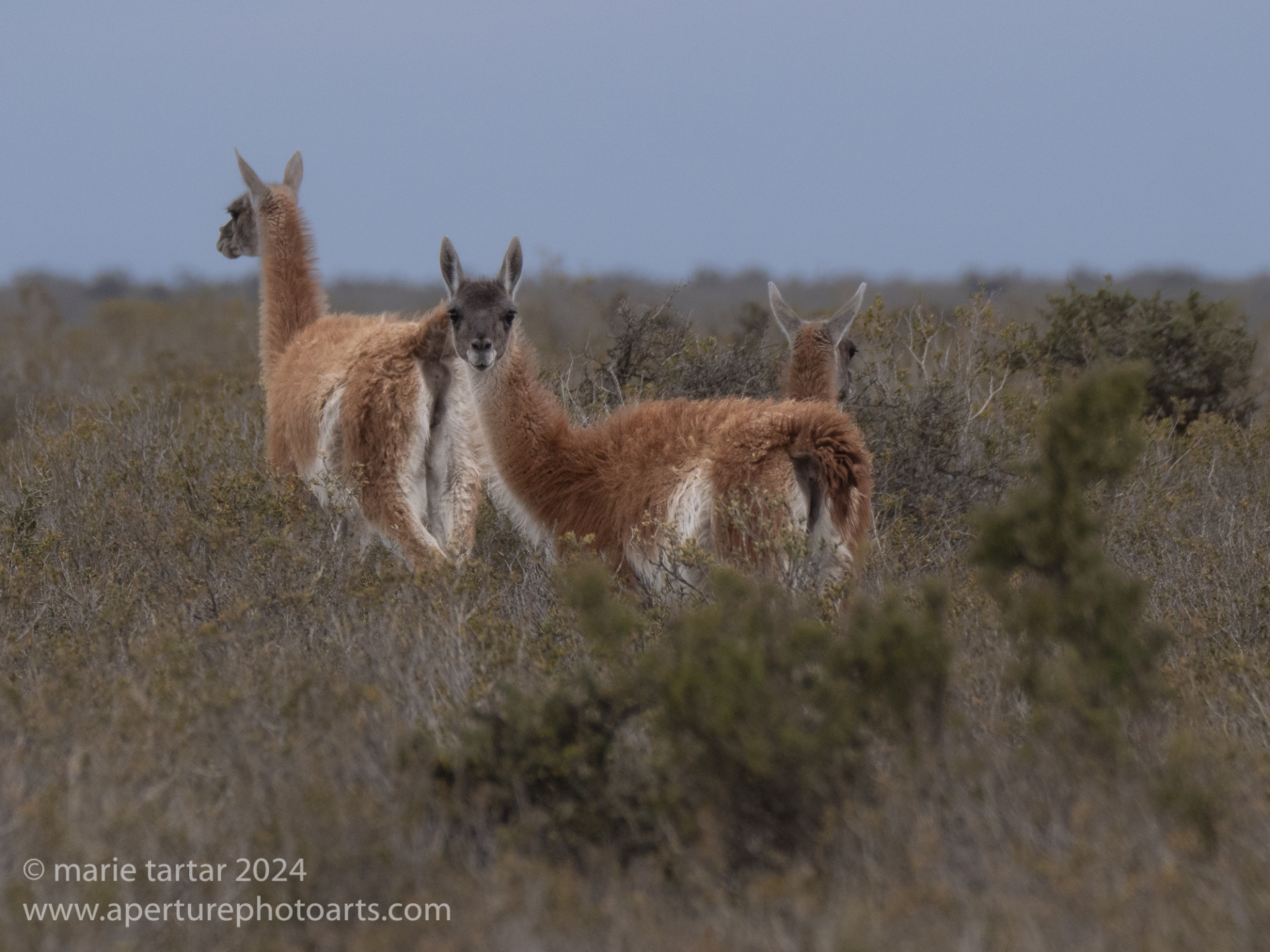
The signature species of Patagonia: guanacos! Peninsula Valdes is in the northern extent of Patagonia.
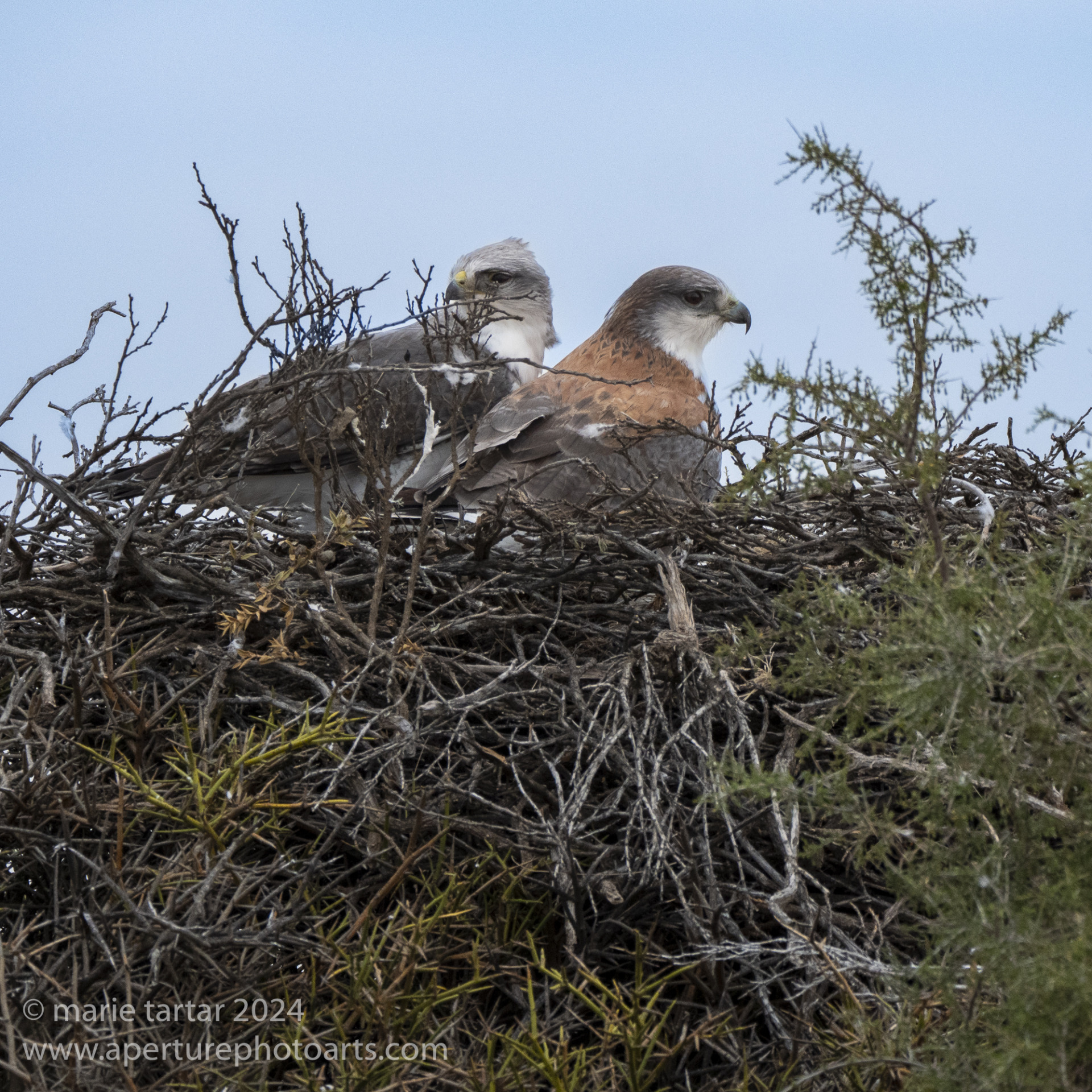
A variable hawk (Geranoaetus polyosoma) couple work on a nest in Peninsula Valdes, Argentina. The female is to the right with the more colorful plumage.
Down at the beach, I flew the drone briefly, despite it being windy and chilly.
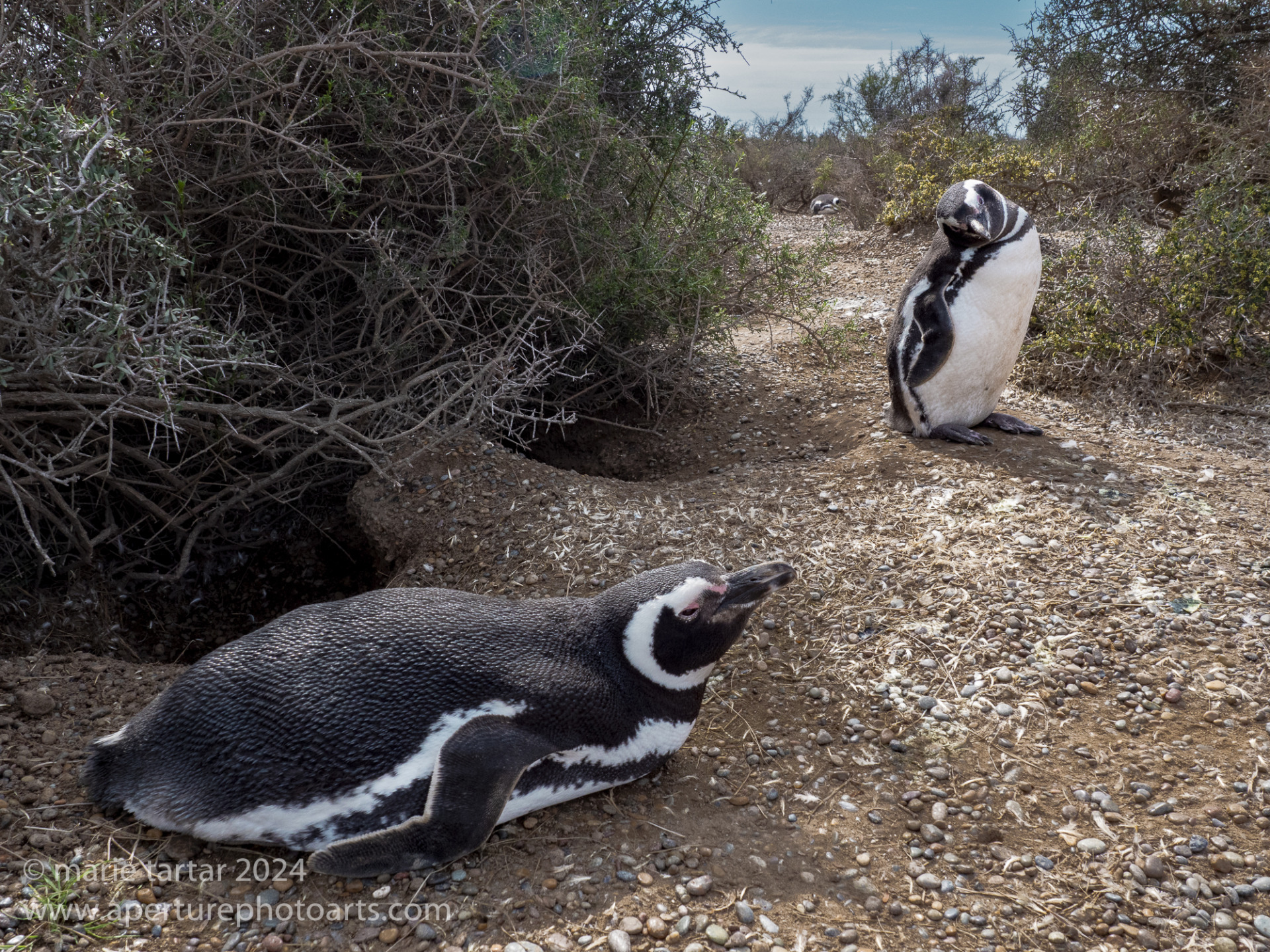
A rather different type of penguin colony than in Antarctica! The largest aggregation of Magellanic penguins used to be Punta Tombo, a few hours south of Puerto Madryn, but Adriana noted there has been a shift in recent years to Punta Norte, presumably the penguins following higher concentrations of food.

A rather different kind of penguin colony from Antarctica! Magellanic penguins (Spheniscus magellanicus) are a burrowing species. This colony is in the north of Peninsula Valdes, Argentina.

Even a week makes a difference in wildlife sightings. Adriana’s prior group saw mostly male Magellanic penguins at this colony, with the females not having yet returned from Antarctic feeding grounds, while we saw a smattering of females and even a little mating action.
Lunch was at the San Lorenzo estancia (lamb, salad, bread and flan). A pair of skittish burrowing owls flew off as soon as a car door was opened. Greg saw movement in the bushes and his first thought was “deer”. That thought was vetoed by Adriana: “There are no deer in Patagonia.” It turned out to be a large local rabbit called a mara. Of course, we had fun with faux “deer” sightings for the rest of the trip.
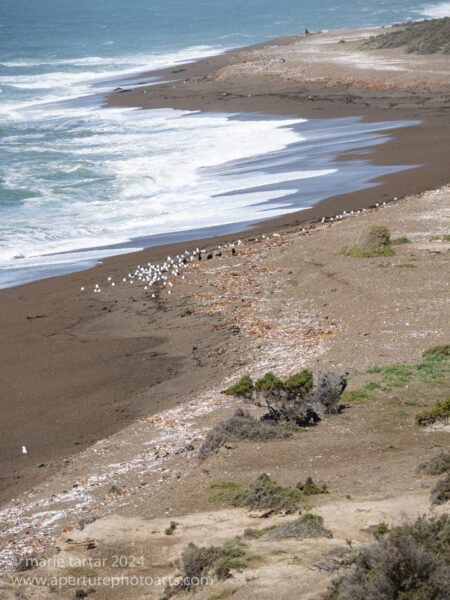
The beautiful beach at Punta Norte, the northernmost point of Peninsula Valdes, Argentina is dotted with seabirds.
At Punta Norte, elephant seals had arrived on the beach since the prior week.
The male tried to mate with all the females in his harem, including one that appeared pregnant.

Mating can be rough! This male bull elephant seal at Punta Norte, Peninsula Valdes, pestered all the females in his harem, one after the other, even those with pups, trying to mate.
Four babies could be seen, sometimes nursing.

Nursing appears exhausting: Female elephant seals sprawled on the beach at Punta Norte, Peninsula Valdes, Argentina, two with small black pups trying to latch on.
A sea lion was surfing. American oyster catchers and seagulls were also on the beach.

Sharp-eyed Hector spotted a crowned night heron nearly hidden in a tree at Punta Norte, Peninsula Valdes, Argentina.
Armadillos were spotted in the parking lot, although remained elusive for photography.
We had pizza for dinner, at El Origen, which we SO tasty, we all had 3 pieces!
Sunday, September 22, 2024
Despite less than optimal conditions, we went out on the water today. Adriana and Hector monitor “el prognistico” constantly and with 5 water days to go and 6 remaining days, choices must be made. Adriana: “Unless the port is closed, we’re going!” We headed out of the harbor to the left to an area whose orientation afforded some protection from the wind. To get there, we took a pounding.

I would have loved to be in the water with this exceptionally beautiful pair of SRWs with distinctive semi-albino markings, but not every mother is amenable.
Adriana loaned me her ankle weights. Greg and I entered the water several times. The first time, we got into a group of three, including an alarmingly inquisitive calf, which prompted our retreat back into the boat. Adriana: “Too lively!”
Our next few passes were hit and miss, some close, but transient. We joked that pulling off our gloves, masks or fins signaled the whales to appear.
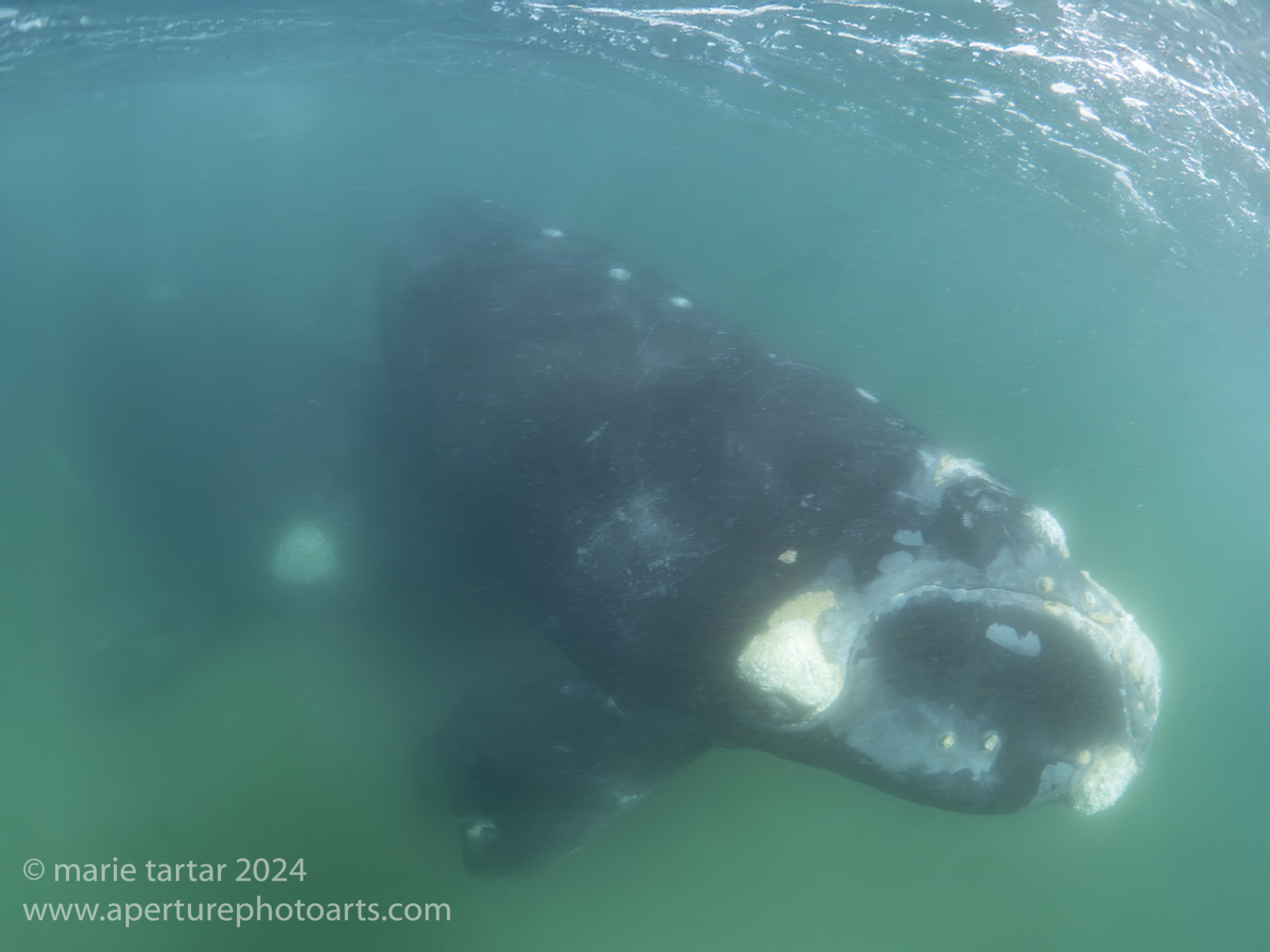
Mother and calf southern Atlantic right whales in murky green water of Golfo Nuevo, Peninsula Valdes, Argentina.

He of the Order of Blue Dry Gloves (Greg). This glove system is difficult to don, with a thermal underglove and the blue kitchen sink overglove needing to be arranged just so to stay dry (with the wrist of the blue glove against skin, not as easy to achieve as it sounds and requiring the help of another person). I have no idea what prompted this pose.
Eventually, we took shelter from the wind, anchoring in a small cove, and munched our lunch of ham, cheese, tomato and pesto empanadas, with lemon cookies with jam centers.
We were slowly making our way back towards the port, the ride much more comfortable, when we encountered an exciting frenzy of activity: a mating group, the southern Atlantic right whale equivalent of a heat run among humpback whales. A white-bellied female was pursued by 4, maybe 5, males, with a gray male consistently in the lead and (we thought) the eventually successful suitor. The female repeatedly turned belly up toward the sky to avoid mating. As Adriana pointed out, since the males work together to flip the female into position to mate, there is an uncomfortable analogy to a gang rape situation.
I tried twice to film this with the drone but encountered a sticky situation where the bird climb to a height from which it would not budge. I had ignored an injunction to log in when flying at the penguin colony. Greg and I guessed after the second time that the drone was being geofenced. We managed to recover it by bringing the boat into closer range but it was touch and go recovering it on the pitching boat.
On our return, Hector mentioned we were invited to a BBQ. Adriana told us this was a delayed birthday celebration for Hector. We picked up wine on the way to contribute, including Otro Loco Mas, a wine from Malbec our BA guide Bernardo had mentioned as a reliable, inexpensive option ($5). We recognized it from the logo, which features a face which turns sad when the bottle is empty and turned upside down. Hector’s longtime colleagues and friends, Claudio (who we met the prior day at San Lorenzo estancia), Luis, Gustavo and Sebastian, had reserved a motel’s function room with a kitchen and welcomed us. Sebastian tended a variety of meats and sausage (chorizo) over an open flame in a huge fireplace, including more exotic organ meats (rinones (beef kidney, best eaten hot, Hector advised), tripa gorda (beef large intestine), corazon (beef heart) and chichulin (small intestine). With a bread roll, I made a version of chori-pan with the chorizo sausage.

Hector’s birthday party, arranged by long-time friends and colleagues, with a plethora or roasted meats and Argentine wines.
We arrived at the party at 8:30 pm and it went on strong until midnight.
Monday, September 23, 2024
We started our day with a leisurely late start, strolling down to the waterfront to the Jorge Schmid dive center for an immersive auditory sound experience, created by hydrophone recordings obtained over the years by Claudio. In a darkened room, we were surrounded by speakers, with the recordings, accompanied by music, evoking a dive, from the trailer backing a boat into the water, to the sounds of southern right whales to orcas to dusky dolphins. The chocolate and orange cookie we sampled afterwards was so exceptional that Greg bought out the remaining stock (both of them), which we later consumed in the truck.
Lunch was down in town at El Viento Viene (The Wind Comes), a cute cafe and shop with enormous sandwiches on homemade bread, accompanied by lemonade, not too sweet, with ginger and mint.
Adriana, Greg and I decided to walk back to the hotel. Passing a sign board of three penguins with cut-outs for our faces, and with no passersby in sight to help, we were stymied trying to figure our how to do a group selfie from behind the board. A young man laden with two full grocery bags who came along was too burdened to ask for assistance, but he kindly volunteered, coming to our collective rescue and did the photographic honors.
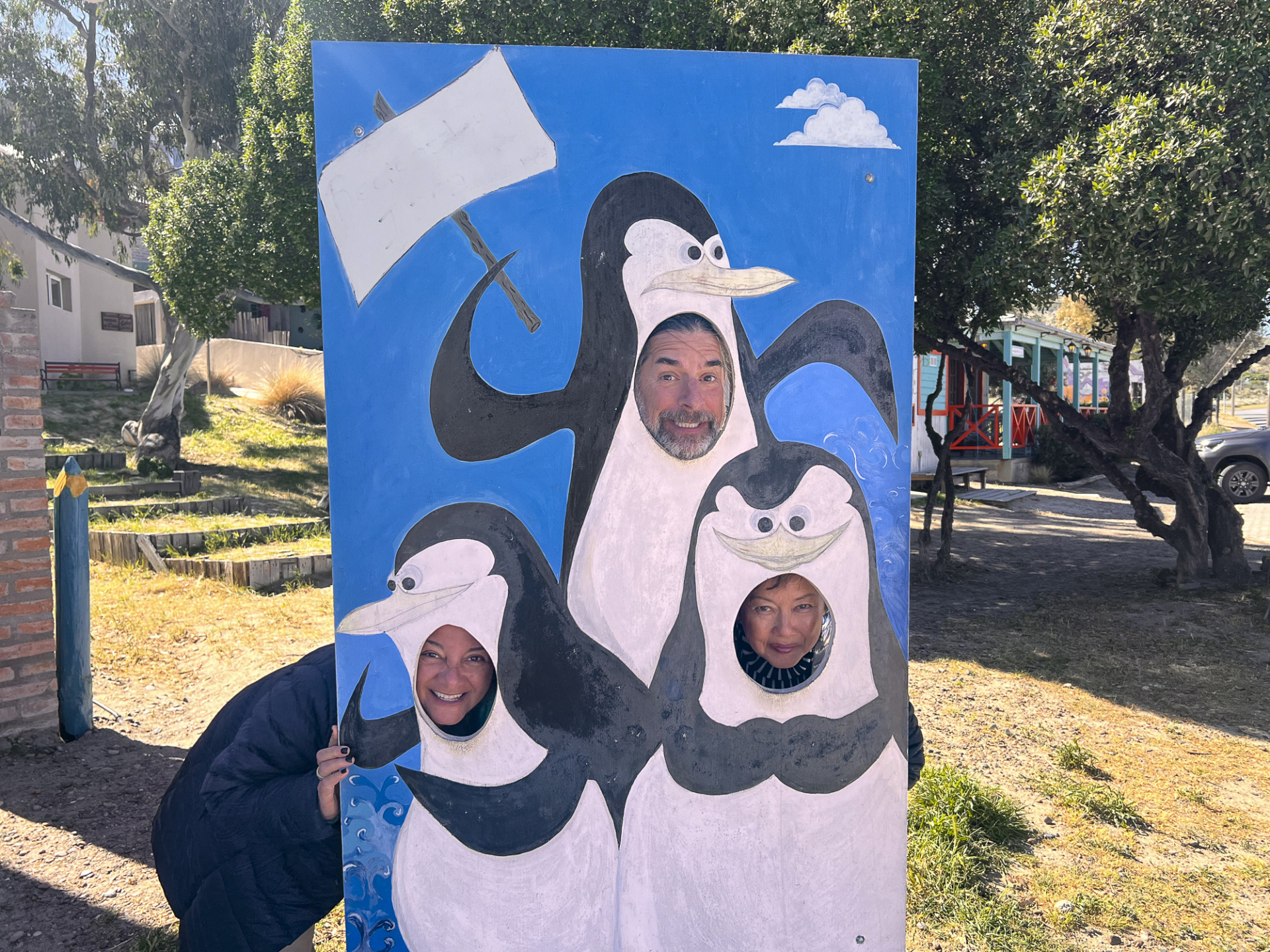
Trying to take this shot without a fourth person didn’t work too well! Puerto Piramides, Peninsula Valdes, Argentina.
Late afternoon, we drove towards the Salinas, Grande and Chico.
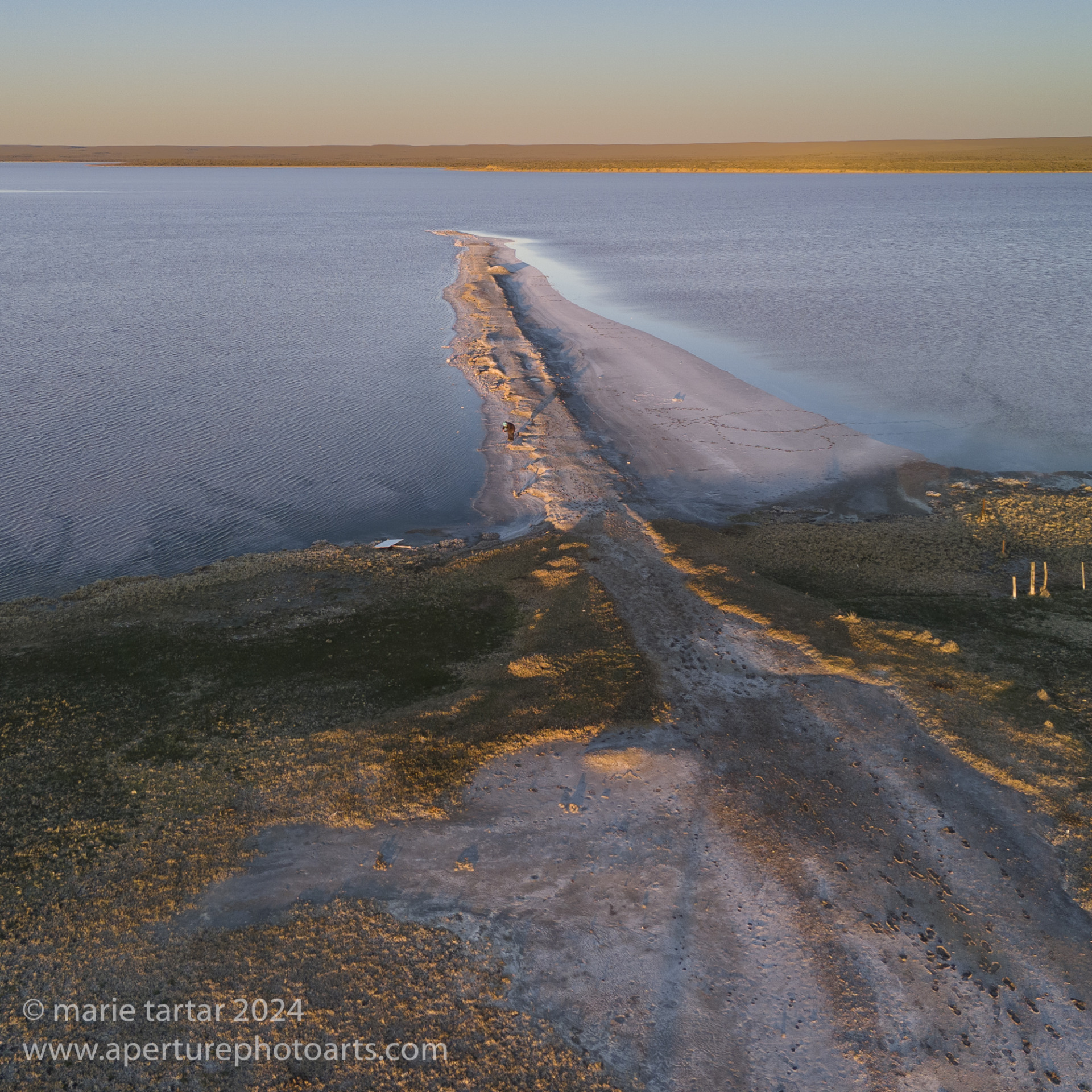
An unusual appearance of Salina Chica, Peninsula Valdes, Argentina. The normally dessicated smaller salt flat was transformed temporarily into Laguna Chica by the recent heavy rains.
Along the way, we encountered burrowing owls, one of which flew out from its nest in a bush on the ground to perch on fence posts which, thankfully, were closer to us. Burrowing owls are so skittish that Hector drove slowly down the road, to allow us to exit the vehicle and crouch in the bed of the truck, after which he slowly drove us back into range of the owl.
After our precautions trying to keep the owl from taking off, Greg and I could barely keep from bursting out laughing when Adriana’s voice came clearly through the back window of the truck: “Do you see the other one in the bush?” Greg: “She’s not using her inside voice.”
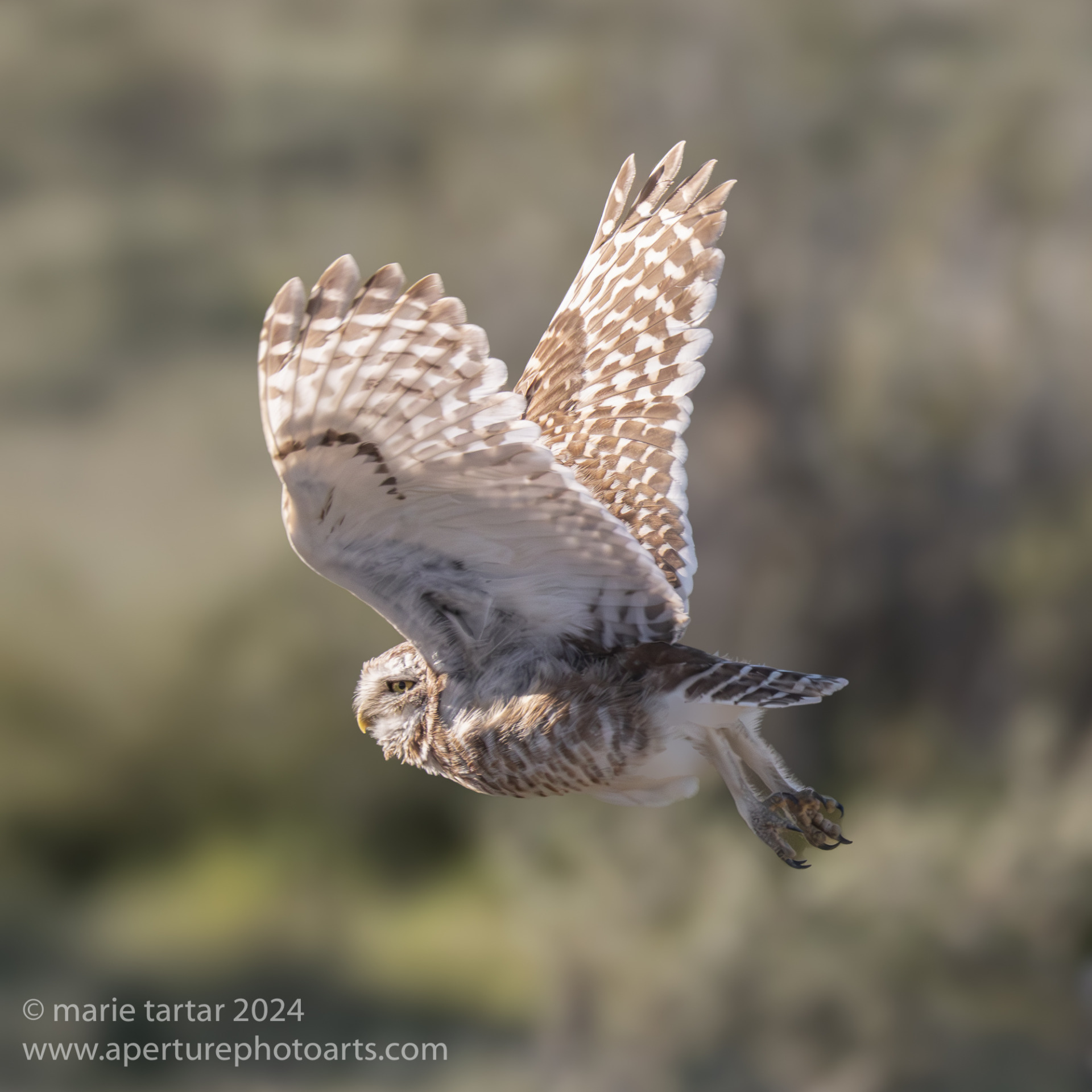
Burrowing owls are skittish! Our barely suppressed giggles and shifting from thighs aching from squatting in the bed of the truck may have caused this one to take flight (on the road to Chica Salina, Peninsula Valdes, Argentina).
Beyond the turnoff to Salina Chica, we found numerous maras and a huge rabbit. A small group of maras proved to be a family, with two tiny babies closely applied to the mother. A pair of juveniles bounding into proximity made the babies tumble into view.
We beat the crowd for dinner at La Estacion. Argentines, even families with children, eat late. The restaurant was packed when we left. I elected the sorrentino pasta (mushroom and ricotto stuffed) with seafood sauce, which proved to be a voluminous quantity of food. We all enjoyed a cocktail new to us, cynar julup. Cynar is an artichoke liquor, which sounds weird, but this translated as an herbaceous taste, not unlike amaro.
Tuesday, September 24, 2024
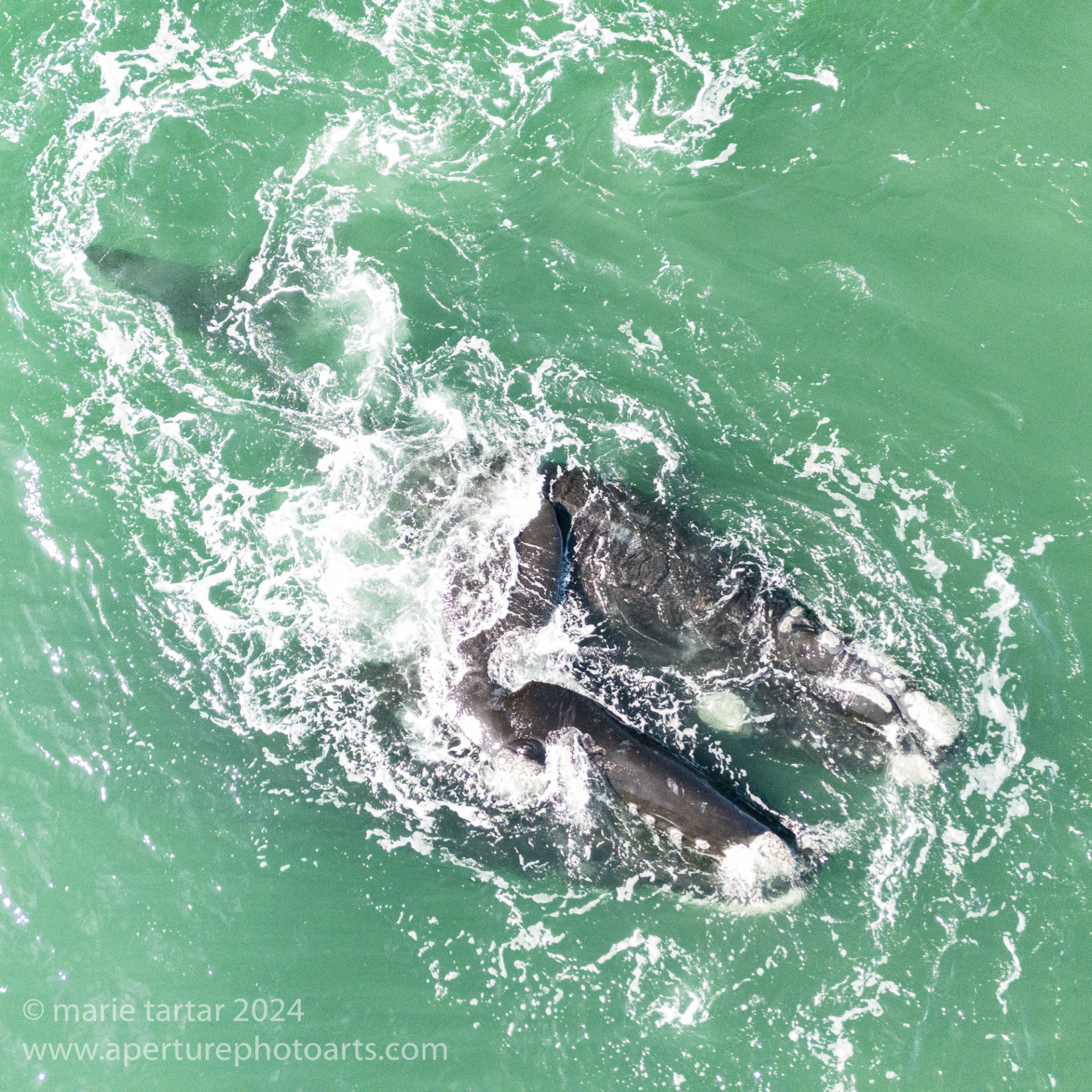
Mating action between southern right whales. Several males pursued a female, circling around and around in the water.
This incredible day started with a successful drone flight over a mating group. Greg helped me get on to the hotel’s wonky Internet the night before, to log in, a new requirement apparently. I ran out of storage on the SD card in the drone before the action was over, but by then, I had plenty of footage and photos.
We had a few whale encounters before making the long (40 minutes) run to a lobería (sea lion colony) accessible only by permit.

Adriana (on right) with her giant dome port. Meanwhile, my dome port was being very closely investigated by a curious southern sea lion.
As soon as the boat stopped, a welcoming committee of inquisitive sea lions swam out from their triangular rocky shoreline perch to greet us. Adriana joined us in the water, which was a mob scene: sea lions darting around and among us, jostling us, nudging our dome ports.

Fun with pinnipeds! These Southern sea lions can’t be visited without a permit, limiting their contact with people. Their curiosity was a bit overwhelming at times.
We stayed until the cold crept in, probably 40 minutes.
More whales were encountered as we made our way back towards Puerto Piramides.
Adriana had an upset stomach and bowed out of dinner and Hector had an engagement with friends, so Greg and I walked into town to El Origen, where we shared a caesar salad (minus the chicken) and a pizza, divided between two new flavor combinations, one with roquefort, mozzarella and walnuts and the other with tomato sauce and capers.
Wednesday, September 25, 2024
Today is Argentina’s National Day of Whales (El Dia National de las Ballenas). The southern right whale is featured on the 200 peso note (roughly 2 cents at this writing), symbolic if not monetary evidence of its importance to Argentina’s national identity.

The southern Atlantic right whale is a symbol of Argentine identity. Two hundred pesos won’t buy much, though.
Captain Jorge is also mayor of Puerto Piramides, so was presiding over the day’s festivities. Quiqui, who we met each morning at the beach driving the tractor which pushes the boat into the water, drove the boat today. He owns one of the dive shops in town.
We had another incredible day today.
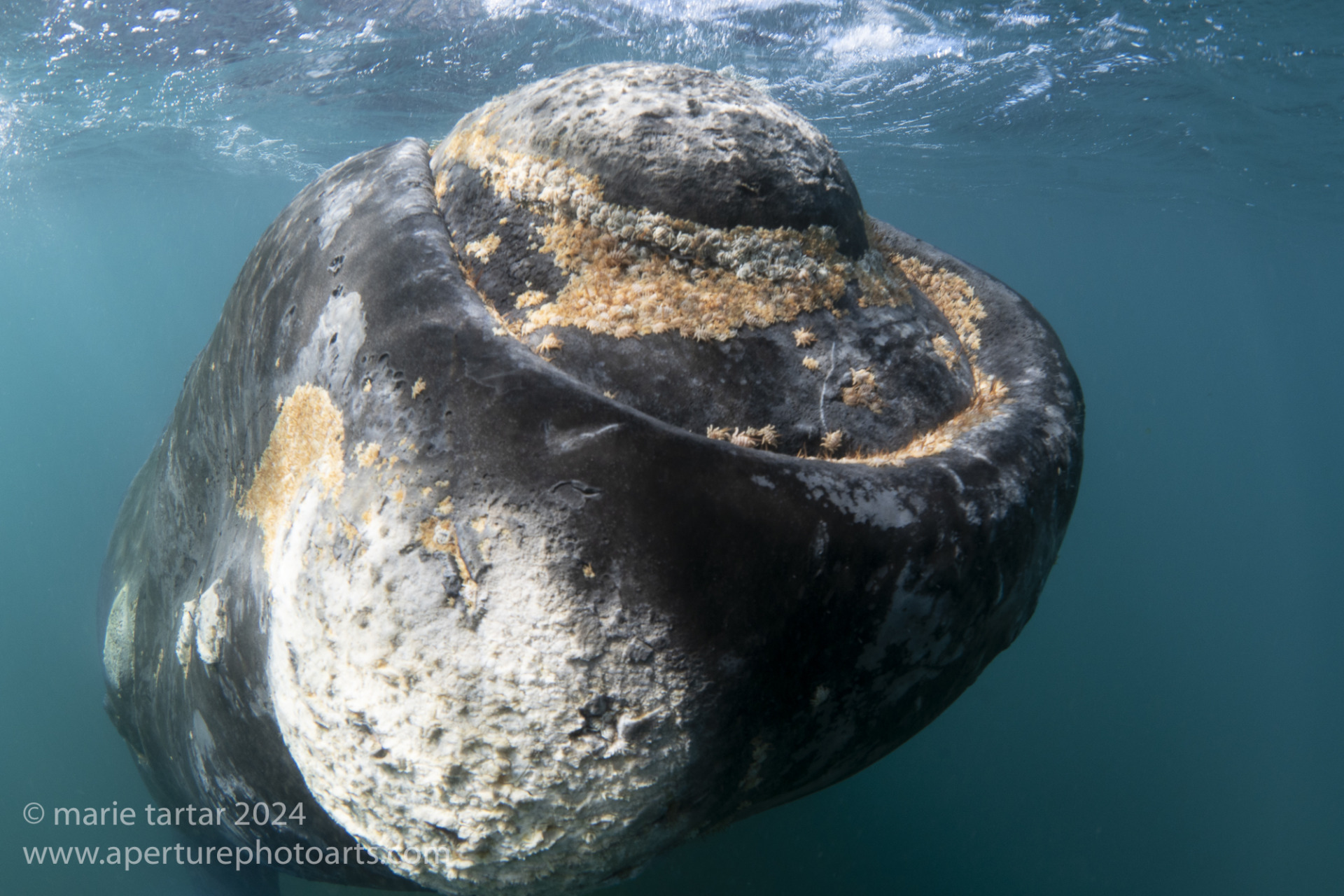
This SRW approached so closely, I had to clone part of my own fin out! The so-called “whale lice” can clearly be seen here to be small crustaceans.
It started later, at noon, as we planned to stay out to shoot as the sun set. In the afternoon , we finally had almost “plachado” seas, with smooth surfaces (apparently related to the Spanish verb, planchar, to iron). This is a running joke with Adriana and Hector, as Clark (Adriana’s husband) who accompanied her on a previous trip, misheard this as “clam chowder’. Not that the visibility was much improved-we still had green murk, despite trying further out for clearer water. Greg and I did spend nearly an hour with a curious and cooperative mother and calf pair. The calf circled around and around us, sometimes appearing right beneath us, causing us to back peddle and me to scream into my snorkel occasionally, much to Greg’s amusement. Today I traded out the 7 mm neoprene Yazbeck socks and Steve’s snorkel fins for my new Fourth Element neoprene SCUBA booties and my SCUBA fins. Adriana stayed out of the water, so I was able to use her ankle weights. I also tried her 5 mm neoprene Waterproof gloves. My gloves are also neoprene, but much harder to don, not having zippers as the Waterproof gloves do.
I also flew the drone over another mother and calf pair, who were soon joined by a third whale, probably a male.
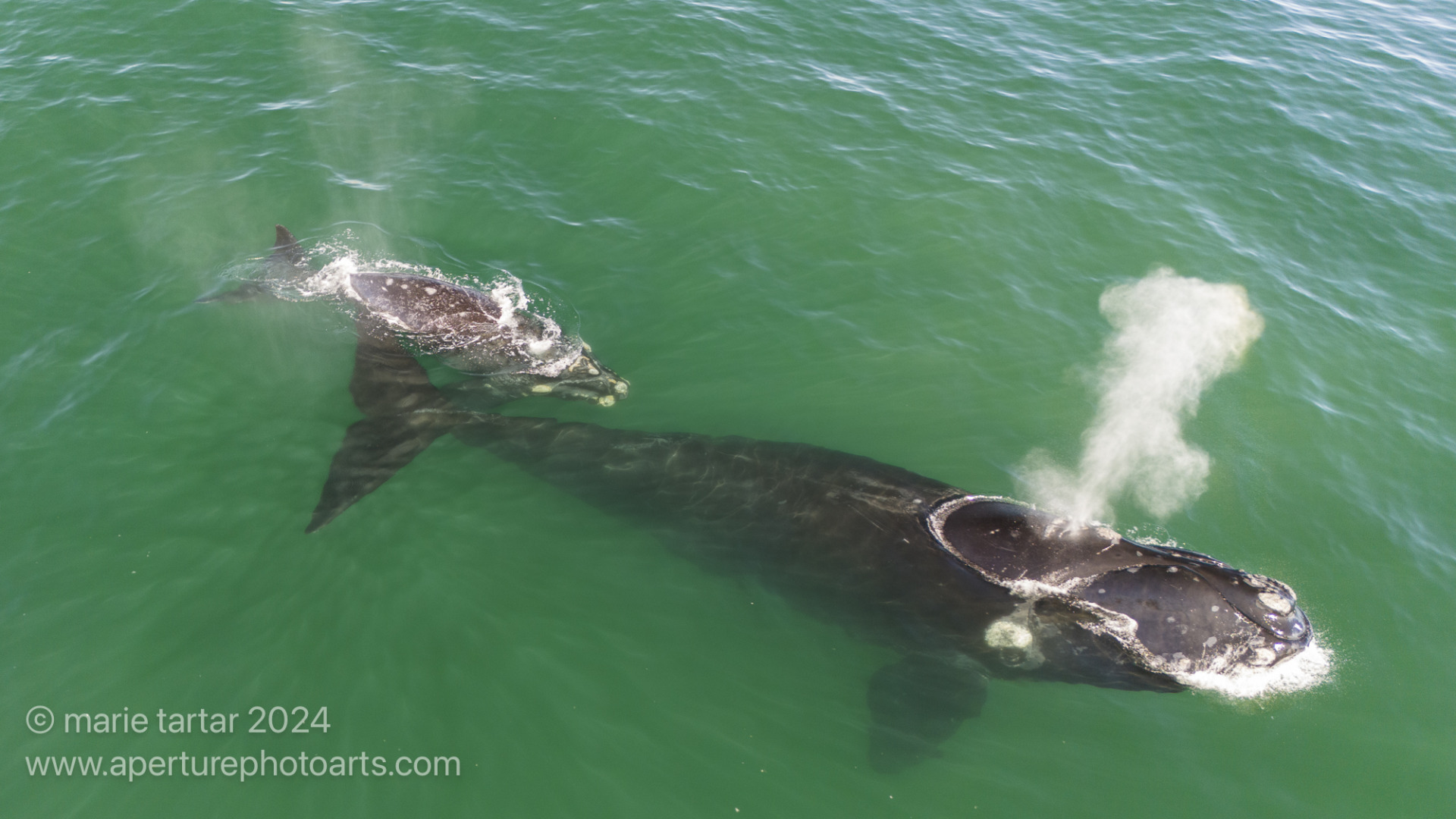
Mother and calf southern Atlantic right whale blows at the surface, Golfo Nuevo, Peninsula Valdes, Argentina.

Like all whales, SRW populations are threatened by ship strikes, line entanglement, underwater noise pollution and fluctuations due to climate change in the distribution of their primary food sources (krill and copepods). Unique to Peninsula Valdes is the threat from seagulls in search of nourishment, pecking the skin of SRWs, causing open sores which may become infected. This is a particular risk for calves. Above, a SRW on the left was forced to dive to evade an attacking seagull.
Our sunset shoot was not graced by whale breaches or even tail slapping or “cola” (tails).
Back at the hotel, I was in for a half hour of strenuous exercise, freeing myself in a hot shower from layer after layer needing to be rinsed and then dried as much as possible. I felt like a farmer tending crops, wringing out what water as I could from gear hanging all over the bathroom and the room, rotating them near the heater, trying to speed the drying. Dinner was at 8:30 pm in the Paradise Hotel’s restaurant. I opted again for a steaming bowl of arroz con mariscos.
Thursday, September 26, 2024
Jorge took us out on the boat today. Yesterday, there was an accident at the beach, in which someone was run over by one of the giant tractors used to transport boats to and from the water.
It was sunny, with flat “planchado” or clam chowder waters, seemingly auspicious.
Unfortunately, the water wasn’t much more clear and our encounters were not extended. Both of us were struck by how much colder, if possible, the water felt.
These auspicious conditions did not last long.
While we were admiring the antics of a white calf leaping acrobatically from the sea, over and over again, pectoral fin slapping and seeming to do everything in its repertoire to keep us from leaving, we planned to head to the lobería for another outing with the sea lions. The wind picked up and the boat strained against it. After progressing only halfway, it was decided that it would be better to try the following day. We had to content ourselves with a surfeit of crispy and marvelous chocolate chunk, walnut and oat cookies which Lala had provided that day.
More comfort food was consumed in abundance that evening at El Origen, the pizza joint: two pizzas with four different combinations of ingredients, a Caesar salad for Greg and me, a pitcher of lemonade and Frenet Branca and coke for Greg and Cynar and soda for me.
And then, we made a tactical error. We’d been invited to an event hosted by a French singer named Yasmine, who Adriana had met during the preceding trip at the local premiere of a movie filmed in the area and featuring Claudio and other local boat drivers and guides, El Senor de las Ballenas. We didn’t really know what to expect but since Yasmine is a singer, we thought maybe this was a concert, part of the Dia National de las Ballenas festivities.
What followed was 2 hours of a strange touchy feely presentation, complete with respiratory exercises. Especially memorable were when Yasmine, through a microphone, exhaled forcefully, drawing in her abdominal muscles dramatically, imitating the whales. She talked a lot but didn’t sing much, except for opening and closing numbers of Isn’t She Lovely? and You Are So Beautiful, accompanied by video and still shots of SRW borrowed from other people. Evidently, she is a yearly whale watcher and has never been in the water with the whales. The evening was somewhat akin to a cult indocrination, although all of the attendants obviously were already whale enthusiasts. Poor Greg had the worst of it, since he doesn’t speak Spanish. Yasmine speaks Spanish fluently and for me, I looked at it as a free Spanish lesson. I had no trouble understanding her, since Spanish is also a secondary language for her.
Hector did not make the mistake Adriana, Greg and I did. After 5 minutes, he bolted. He had strategically positioned himself close to the door. We were walking distance to the hotel and Hector met us there when we finally escaped.
Hector: “Two hours!”
Friday, September 27, 2024
Today was our last full day in Peninsula Valdes and our last day on the water. We were hoping that today would be the day auspicious conditions came together and we were overjoyed that it (mostly) did, with “clam chowder” flat, planchado seas, better visibility (still not great but definitely improved) and very close and prolonged, encounters.
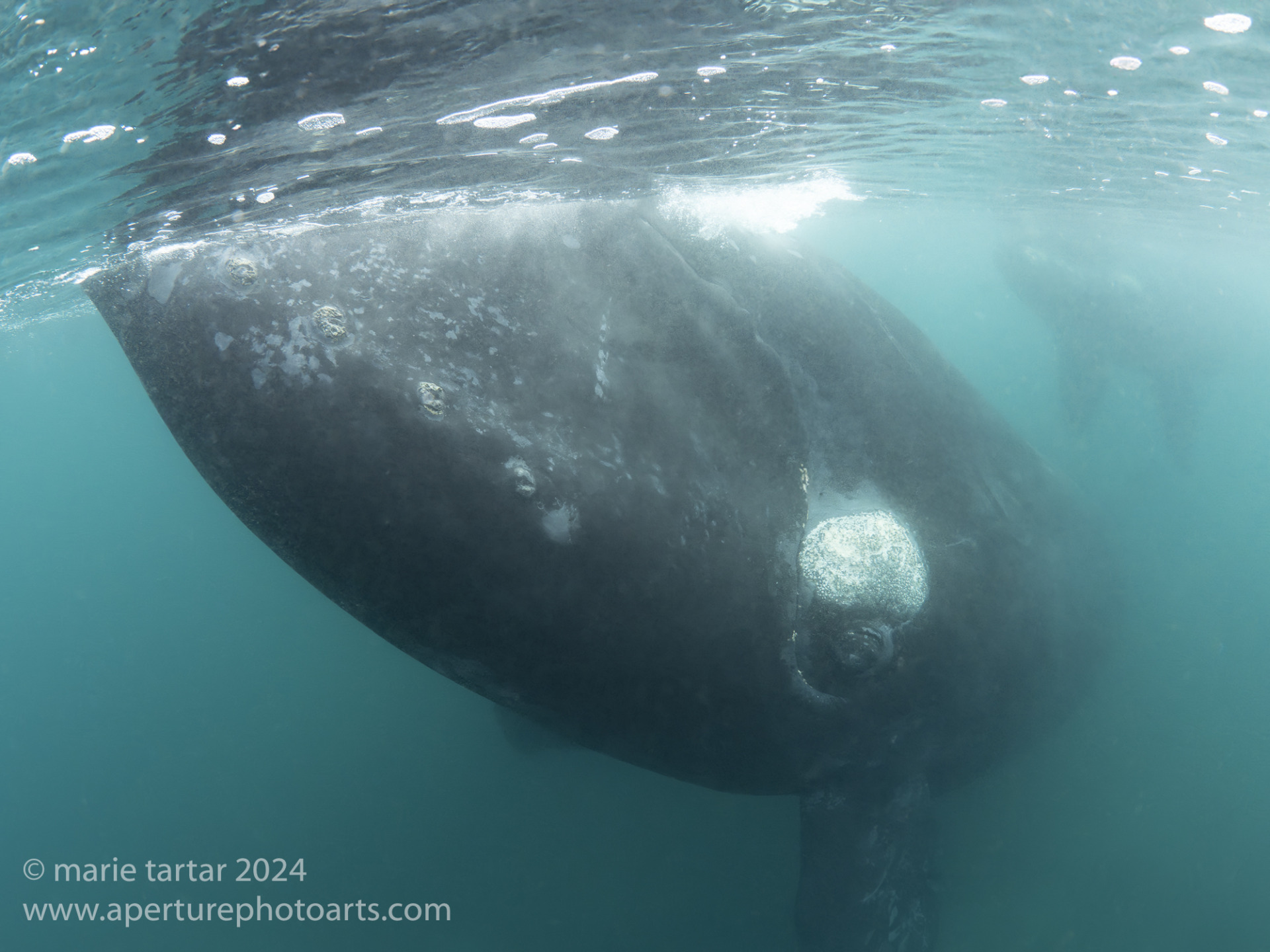
This mother SRW eyeballed us closely multiple times. The water is so murky the calf is only seen faintly behind her.
The day started with an extended encounter with a mother and calf.
The calf was inquisitive enough that we had to retreat back onto the boat but were quickly back in.

SRW look strange initially when seen from the front. Their baleen plates, with which they feed by straining sea water for microscopic krill and copepods, hang from the top of their mouth.
Dusky dolphins, attracted by our beating fins on the water’s surface (opposite strategy of whale encounters) came around twice, albeit briefly.
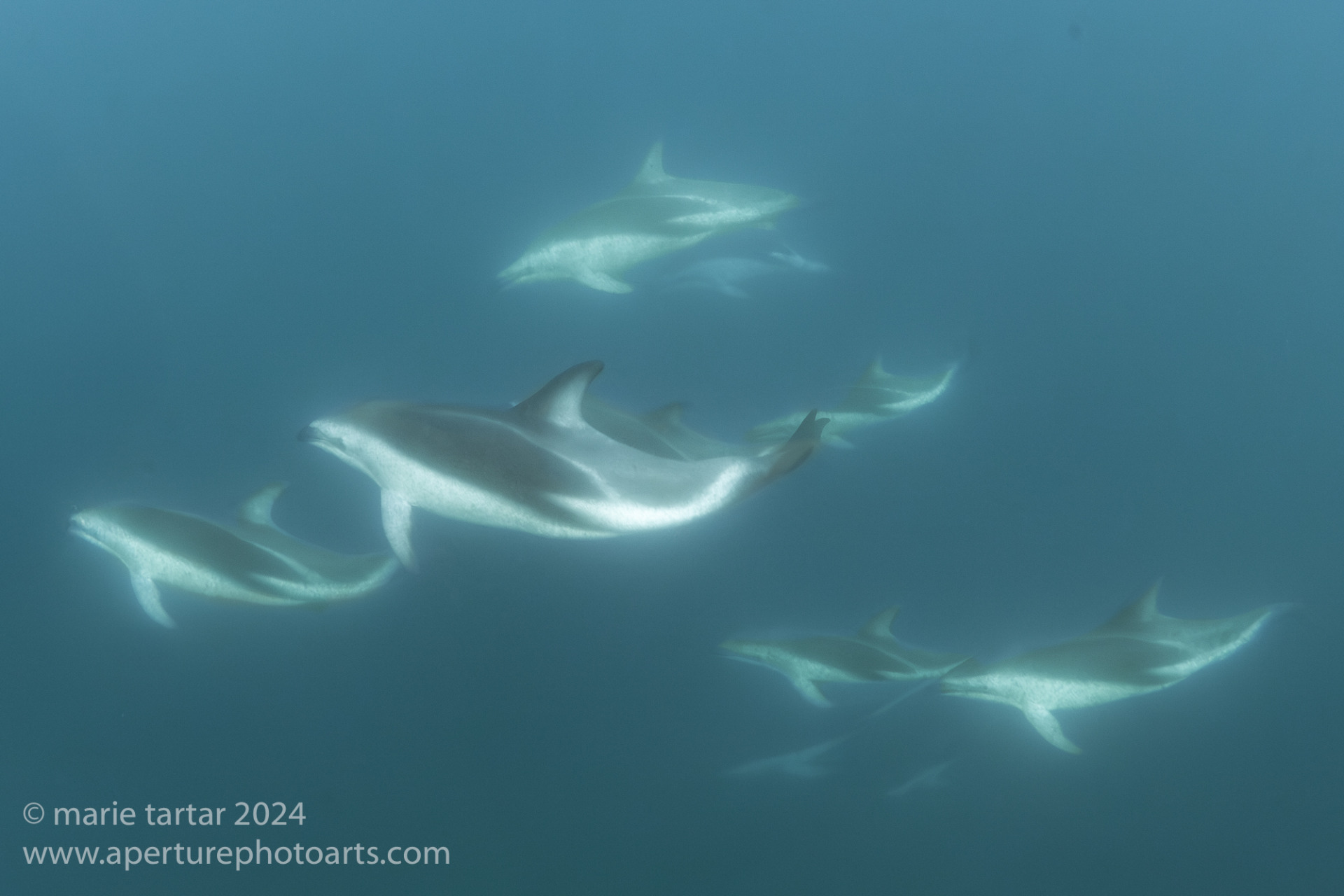
Dusky dolphins! The fast moving dolphins weren’t fooled twice by our fin slapping on the surface; they came around twice, albeit briefly.
We had an amazing afternoon at the lobería, the rarely visited sea lion colony.

A delightful southern sea lion mob scene at a rarely visited lobería, requiring official permission to visit (namely, a government issued permit).
Adriana joined us in the water. She and Greg were adopted by a baby sea lion who draped itself over them, even sat in Adriana’s lap and returned repeatedly. The sea lions mobbed me, pushing their snouts onto the dome.

Sea lion colony, Peninsula Valdes, Argentina: I acquired a medium size dome port in anticipation of this trip, having been frustrated in Misool in March by being unable to try over under shots like this, with my wide angle set-up being a WWL-1 (a wet lens).
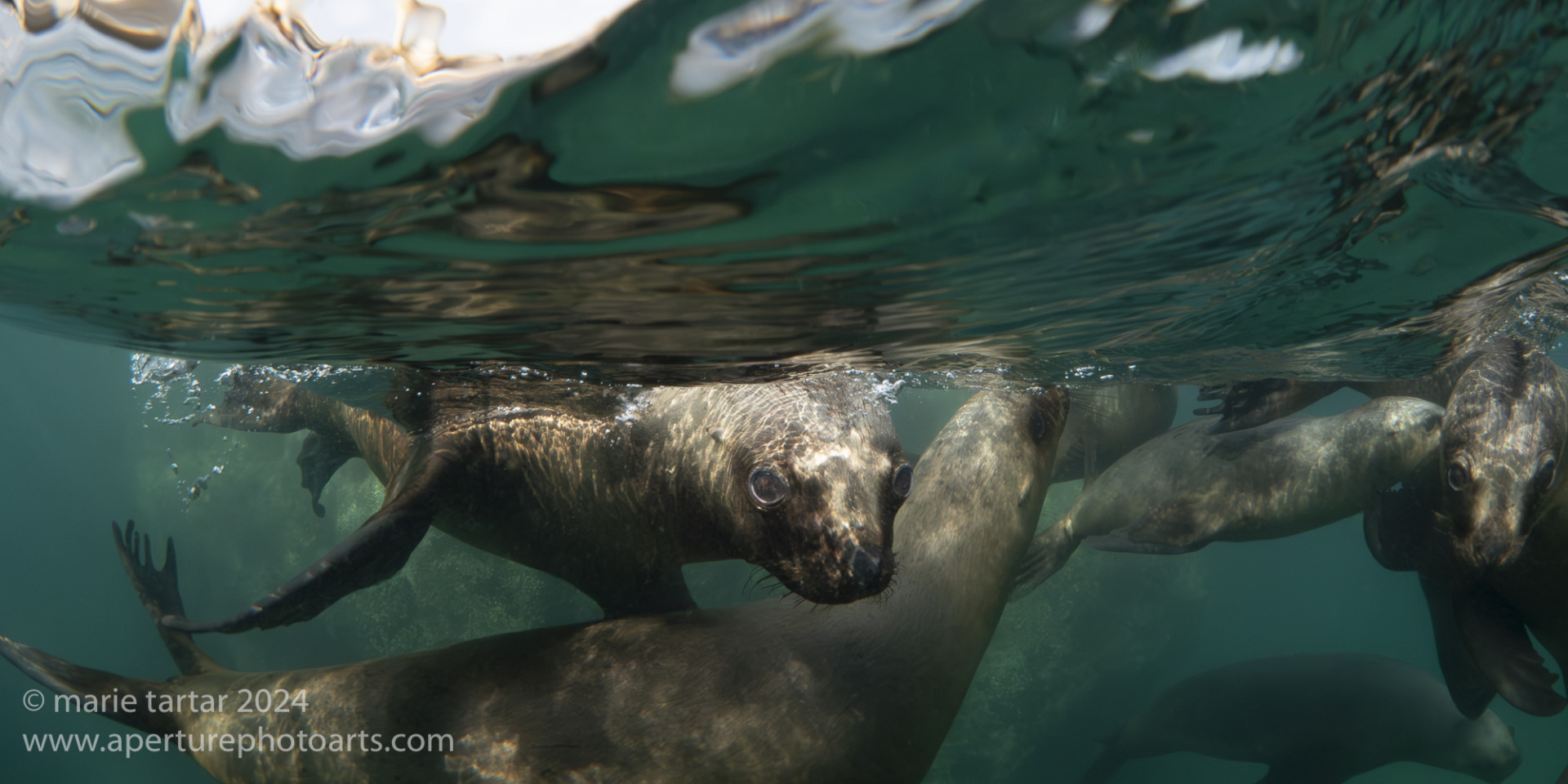
Even with a kickboard, it’s difficult to have any control over the meniscus (the water surface interface) with over unders. This is taken within fractions of seconds of the above. I was surprised to hear from Adriana (with an even bigger dome port affording her a larger margin of error) that she just shoots without looking through the viewfinder. Evidently many successful over unders are the result of the law of averages and a little luck.
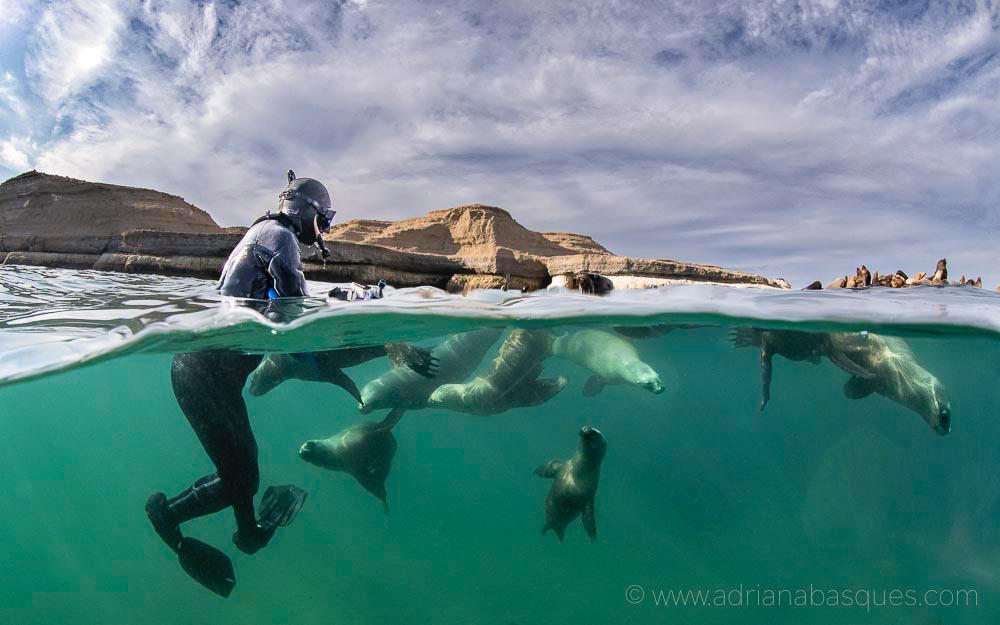
Adriana’s shot of me at the lobería, propped up on a blue styrofoam kickboard, valiently trying to control the meniscus of the water’s surface for over-unders!

Dinner at La Estacion, one of four restaurants on our nightly rotation in Puerto Piramides. Adriana and Greg trying to look erudite, evidently.
Even the sunset on the return was dialed up to dazzling effect. Claudio joined us for dinner at La Estacion, where I had a final helping of arroz con mariscos.
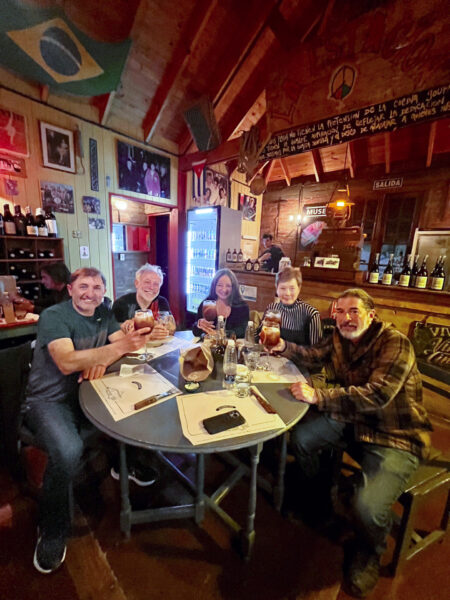
Farewell dinner at La Estacion, with (from left) wildlife guide extraordinaire Hector, Claudio (who captained our boat on our last day on the water), Adriana, me and Greg.
Saturday, September 28, 2024
Our travel day was capped off by a quick turnaround in BA for a late dinner. Originally, we had booked a return flight from Trelew which would have arrived in BA’s domestic airport with just enough time to transfer to the international airport to fly out the same night. But, the best laid plans…are bound to be adjusted by the airlines. With a month to go, we received notice that Aerolineas Argentina had changed us to flying out later, from a closer airport, PMY (Puerto Madryn). Flying to the US the same night was no longer an option. I had wanted to, in order to make it to NY the morning of Steve’s birthday, but that was now off the table.
American Airlines was kind to me, switching me to the same nonstop night flight the following day and only charging me a $40 change fee. Greg did not get off so easily. If he wanted to fly out the next night, United wanted $1250. If he waited two days, the fee would be $345. He elected to stay two extra days in BA.
The upside of this flurry of changes was another chance to sample BA’s culinary scene and to take Adriana out to thank her for organizing such an amazing experience. Thus, after a very short turnaround in BA, we indulged in a multi-course seafood meal at 10 pm at Crizia, within walking distance of the Miravida Soho. The wine pairing was a glass too many, enough so that the followig morning, the thought of an afternoon wine tasting (previously arranged at the hotel) did not sound very appealing.
Sunday, September 29, 2024
Today was Steve’s birthday, spent by him on a Jetblue flight to NYC. I had planned to leave BA in time to make it into NYC this morning, but Aeolineas Argentina had other plans for us, changing our return flight to BA to later in the day, so that we couldn’t make it out the same day. AA was kind to me, only charging $40 to change to the same flight a day later. but United (despite his 1K status) had other plans for Greg, leading him to stay 2 more nights in BA rather than fork over more than $1250 to fly home one day later.
Adriana was gone in the morning when I had my final medialuna croissant downstairs. Greg was across the street at Scarlett’s sampling their pastries. We walked Palermo, finding ourselves in a street fair, where Greg bought us fresh Tshirts for the trip home from a woman who taught anatomy at a hospital in BA for 13 years.
Despite not really feeling it in the morning, we did enjoy our guided wine tasting with Sandra at 2 pm, down the stairs at the hotel in a dedicated room.
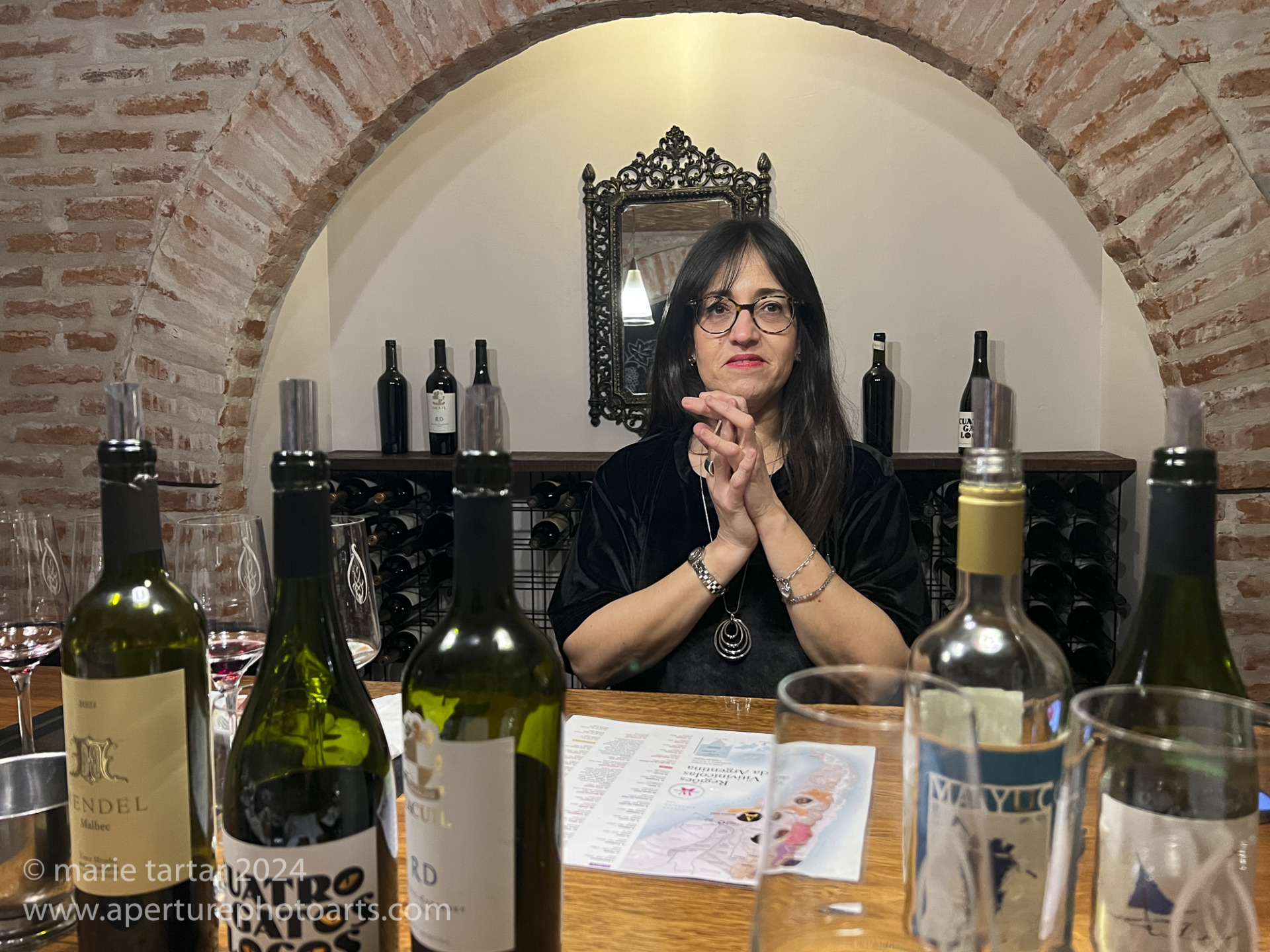
We recovered enough from dinner at Crizia the night before (with an overly generous wine pairing) to enjoy a guided wine tasting with Sandra the next afternoon at the hotel.
We spent the late afternoon strolling through the nearby zoo. Peacocks were meandering around and maras were abundant, ironically much closer than we had strained to photograph in the wild with our 400 mm lenses. A mara with a baby was now just a few feet from us, separated only by a natural agave hedge.
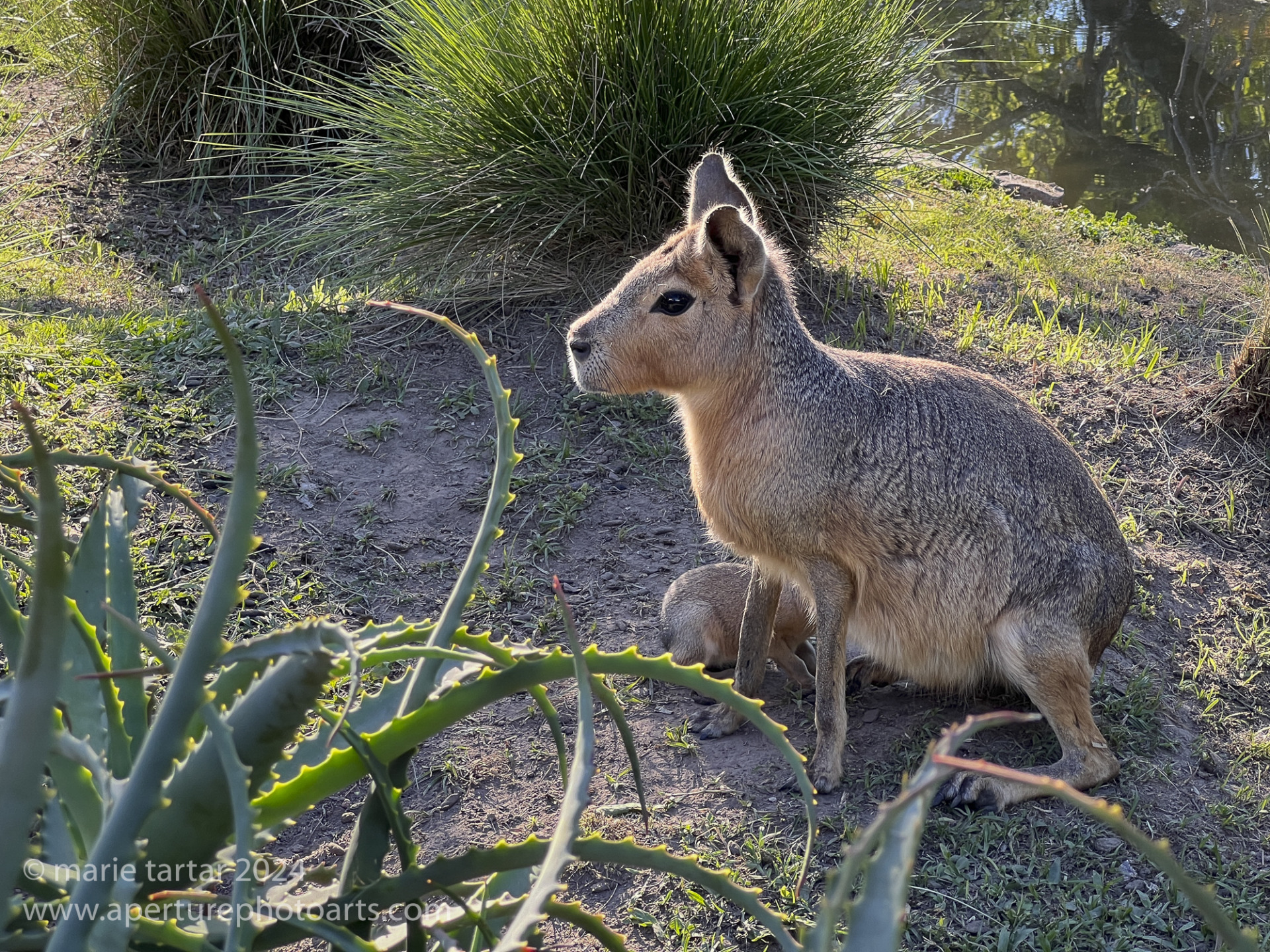
Adult mara with baby, way easier to photograph in the open air Buenos Aires zoo than in the field with a 400 mm lens!
I had an interesting conversation with my Uber driver Daniel on the way to the airport. He confirmed what Captain Jorge had said about how difficult a life doctors have in Argentina, saying the men who pump gas into vehicles at service stations (like in New Jersey, you can’t pump gas yourself) make a salary comparable to doctors. Daniel mentioned he had an uncle who was a plastic surgeon who practiced in Santiago, Chile for that reason. I was astounded to learn, chatting with him on the boat, about Jorge’s stressful 20-year career as an emergency physician in BA, working 6 days a week and no vacation the last 3 years, which led him to give it up for Puerto PIramides and a lower stress life captaining our whale watching boat.
Astrid kept me company on the ride home. This French television show had been mentioned to me in the context of “If you liked the Extraordinary Attorney Woo (I loved this Korean television series, including her whale obsession), you would like this French program, Astrid (titled in Britain, Astrid: Murder in Paris)”. Like the extraordinary Attorney Woo, Astrid is autistic and has a photographic memory, which is employed as an archivist and investigator for the police in solving unusual crimes.
We had such a great time on this expedition that it wasn’t long after returning home that Greg and I were plotting a return. Surprisingly, Steve still is disinclined to join us on this cold water SRW adventure. We’re all already scheduled on a dive trip to New Guineau in 2025 during the season, so we’re looking at 2026 and hoping for better visibility to accompany incredible encounters. We had a chance to compare notes with Margi and Eric, who accompanied Adriana immediately before our arrival, when they came down in November to see our joint exhibition in November at the Photographer’s Eye gallery in Escondido. They definitely lucked out with better visibility. Looking back at the images, I am still in shock and awe, recalling how, at times, we could be just a few feet from the rostrum of a SRW, poking out of the water, while barely being able to see the enormous attached body below the surface!
-Marie

A SRW calf eyes me curiously. Their innate curiosity and tendency to swim close to shore, as well as the fact that their abundant blubber causes them to float after death, made them the “right” whale to target during the 1800s, leading to near extinction. Thankfully, Argentina and Peninsula Valdes are leading a slow recovery of their numbers, now estimated at 12-15 thousand worldwide.





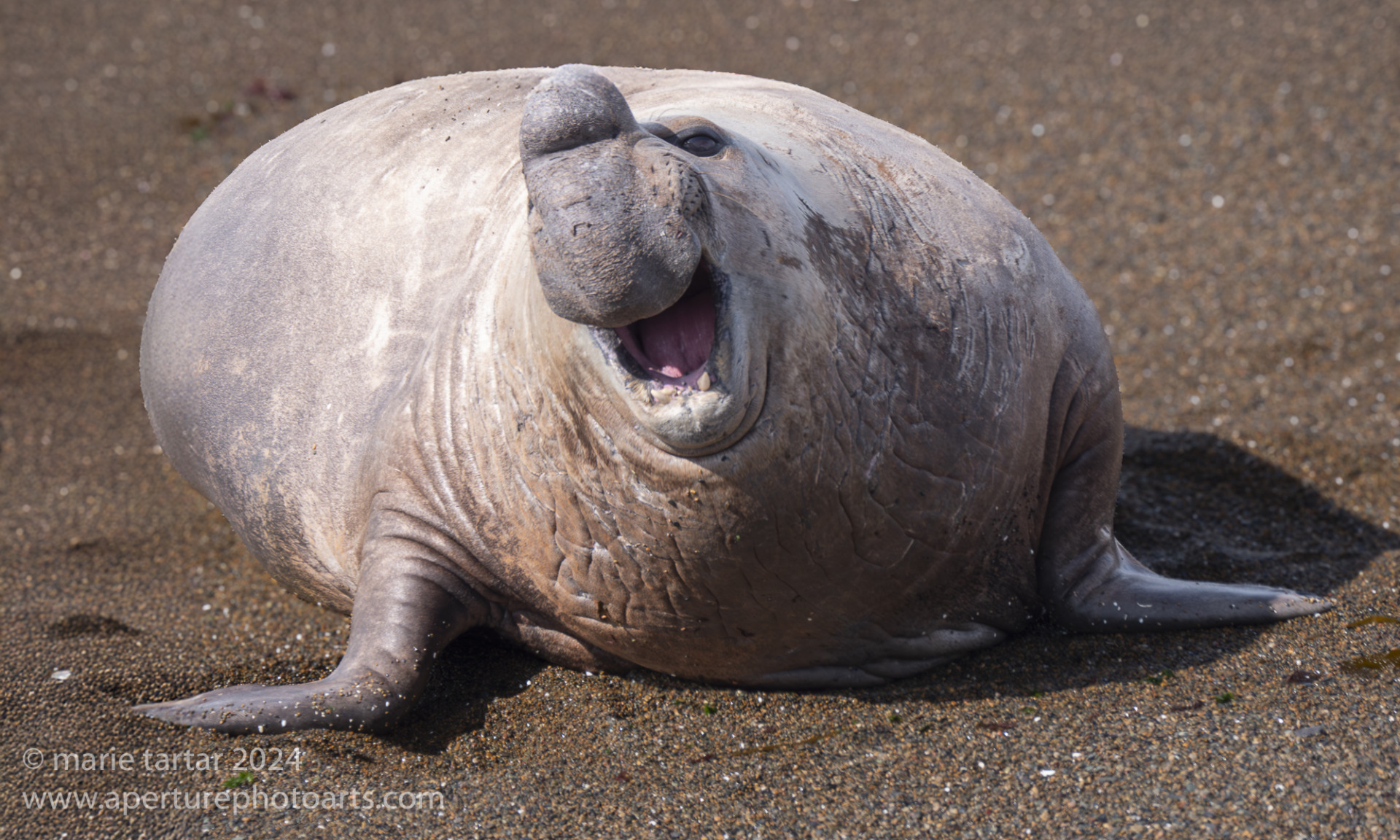


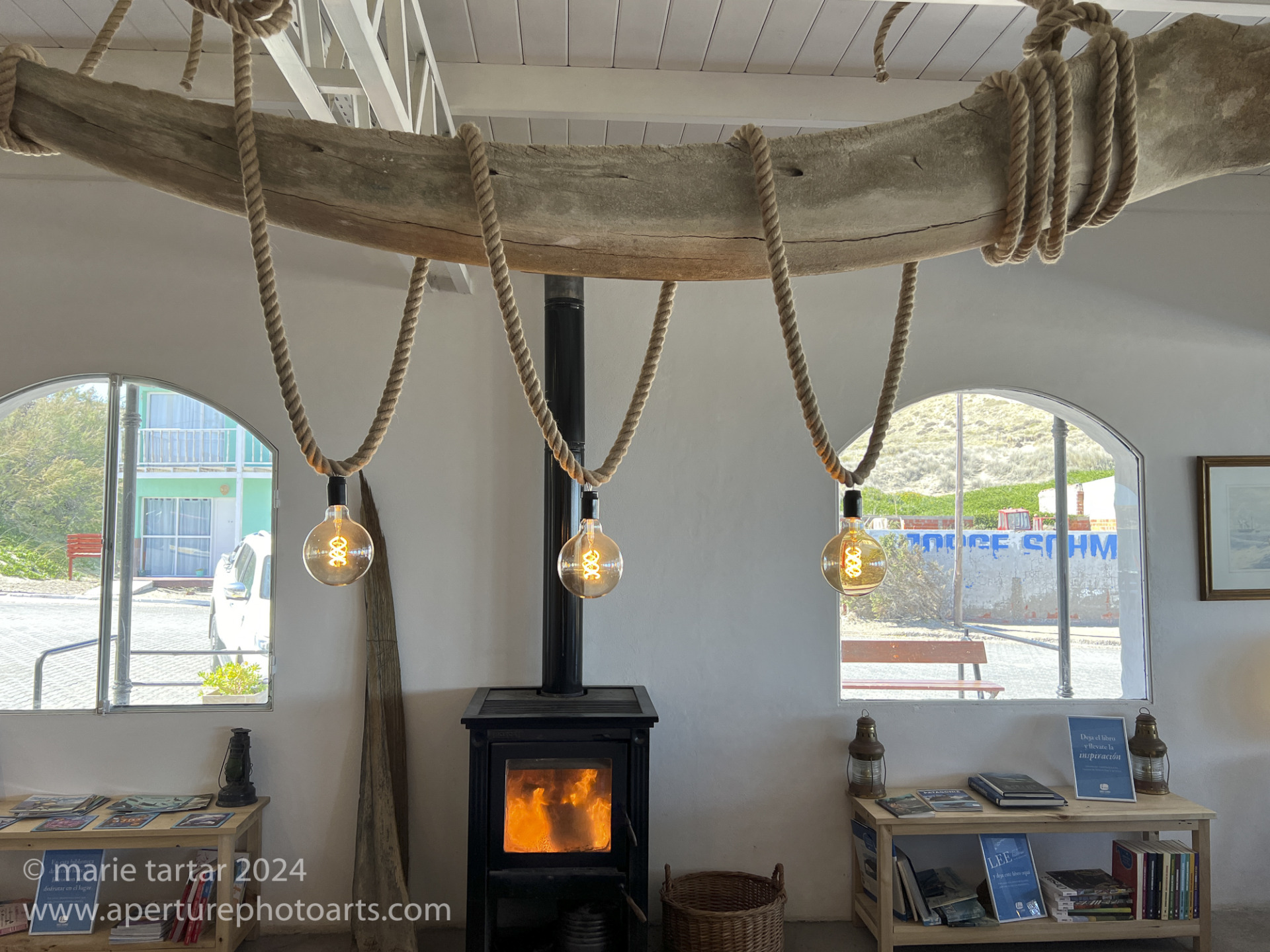

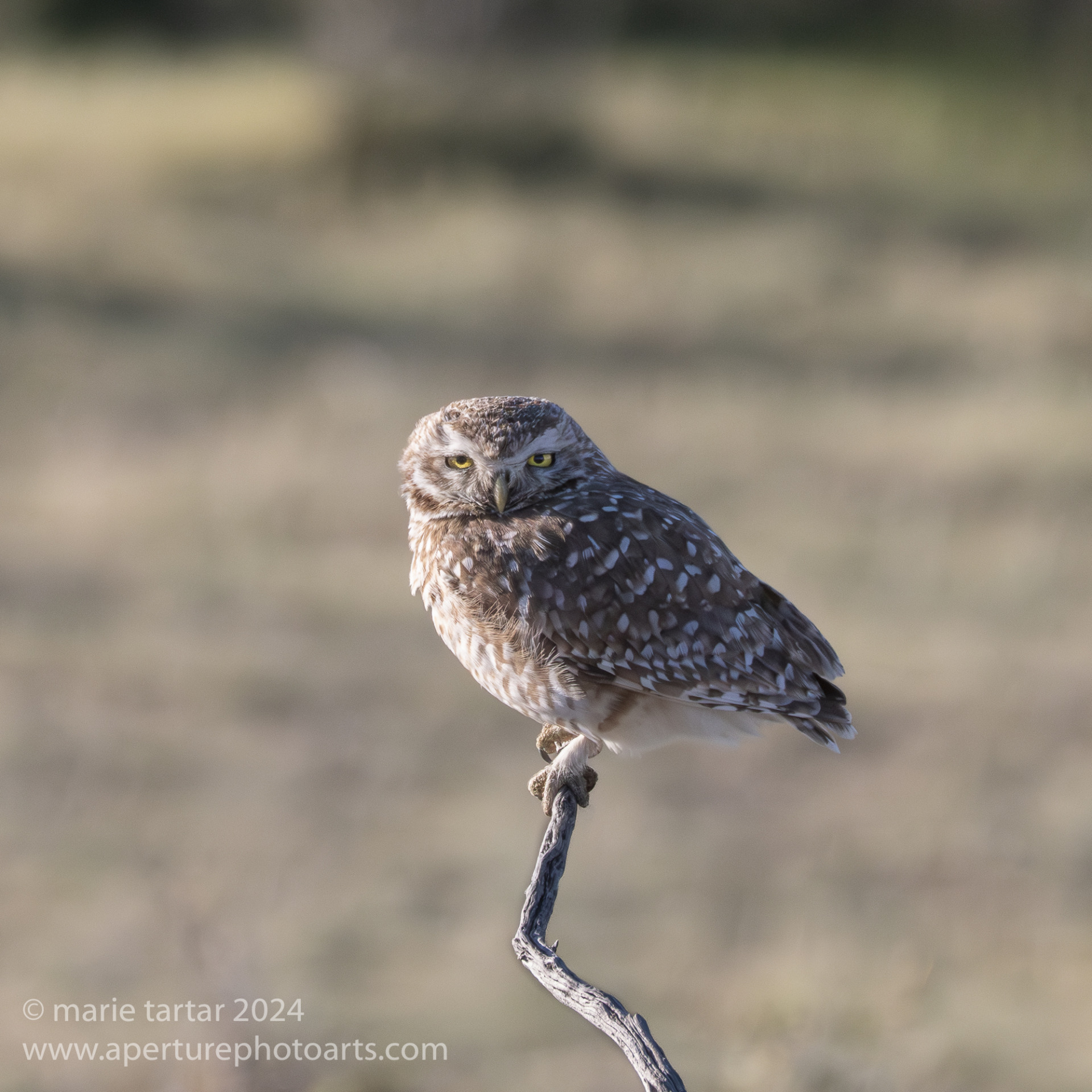


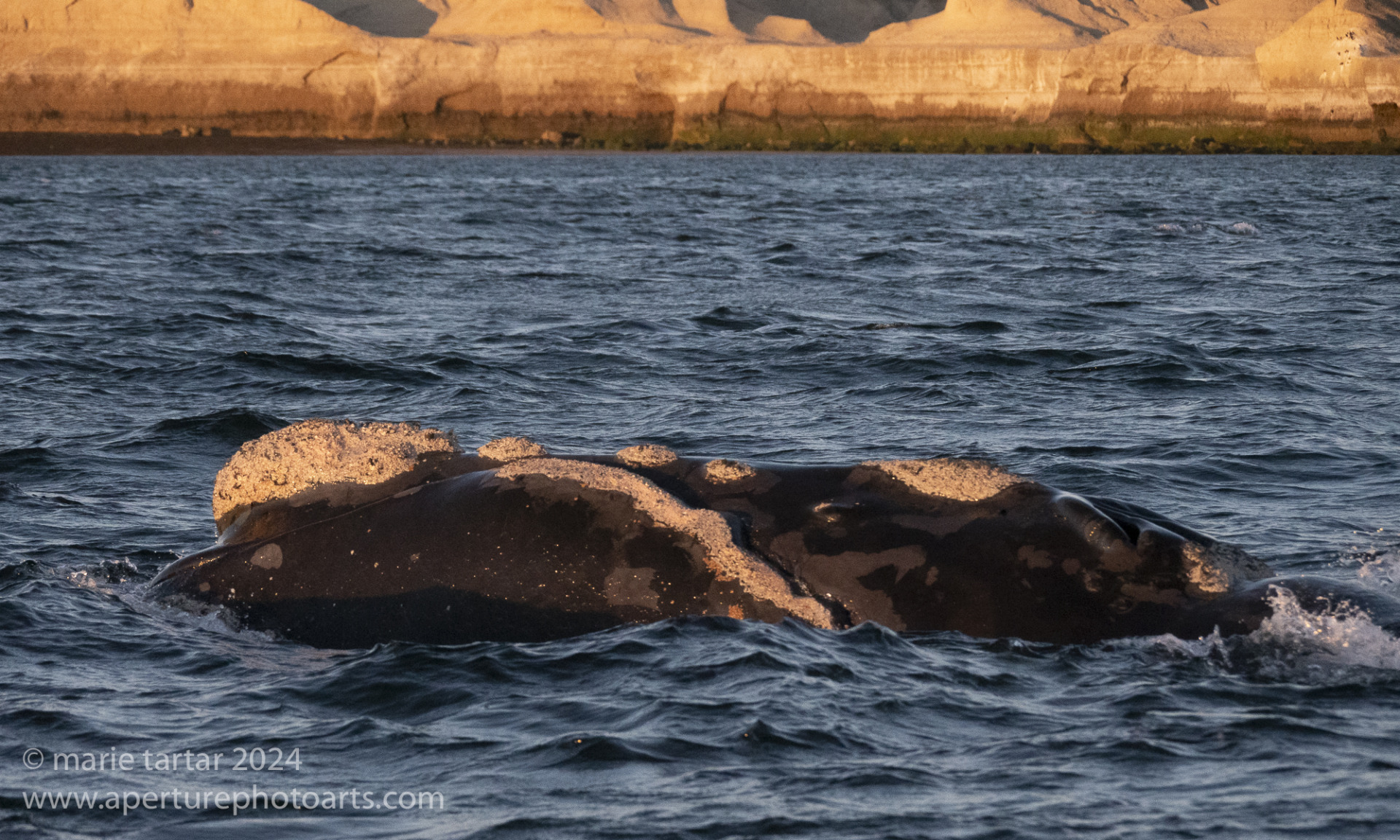
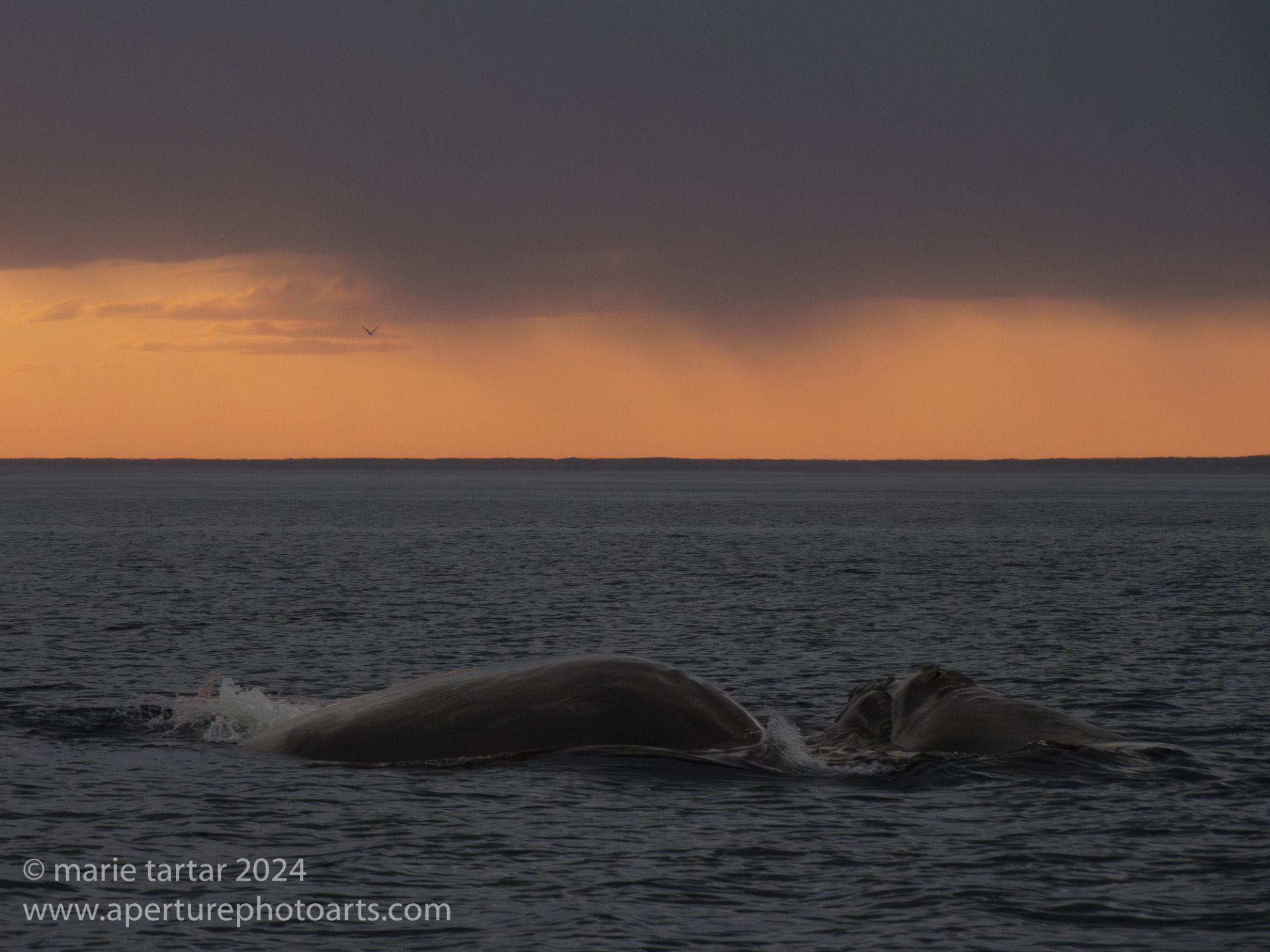

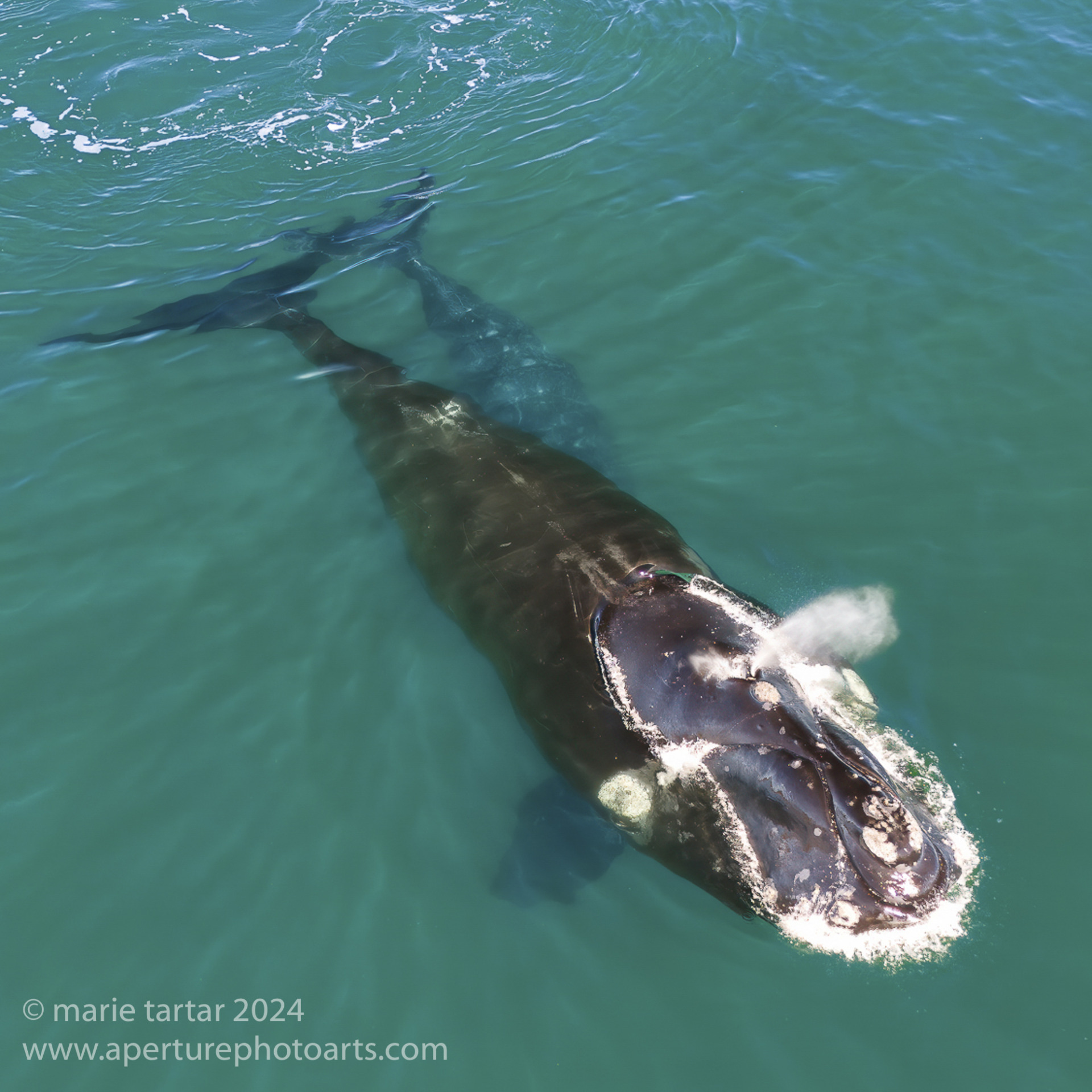

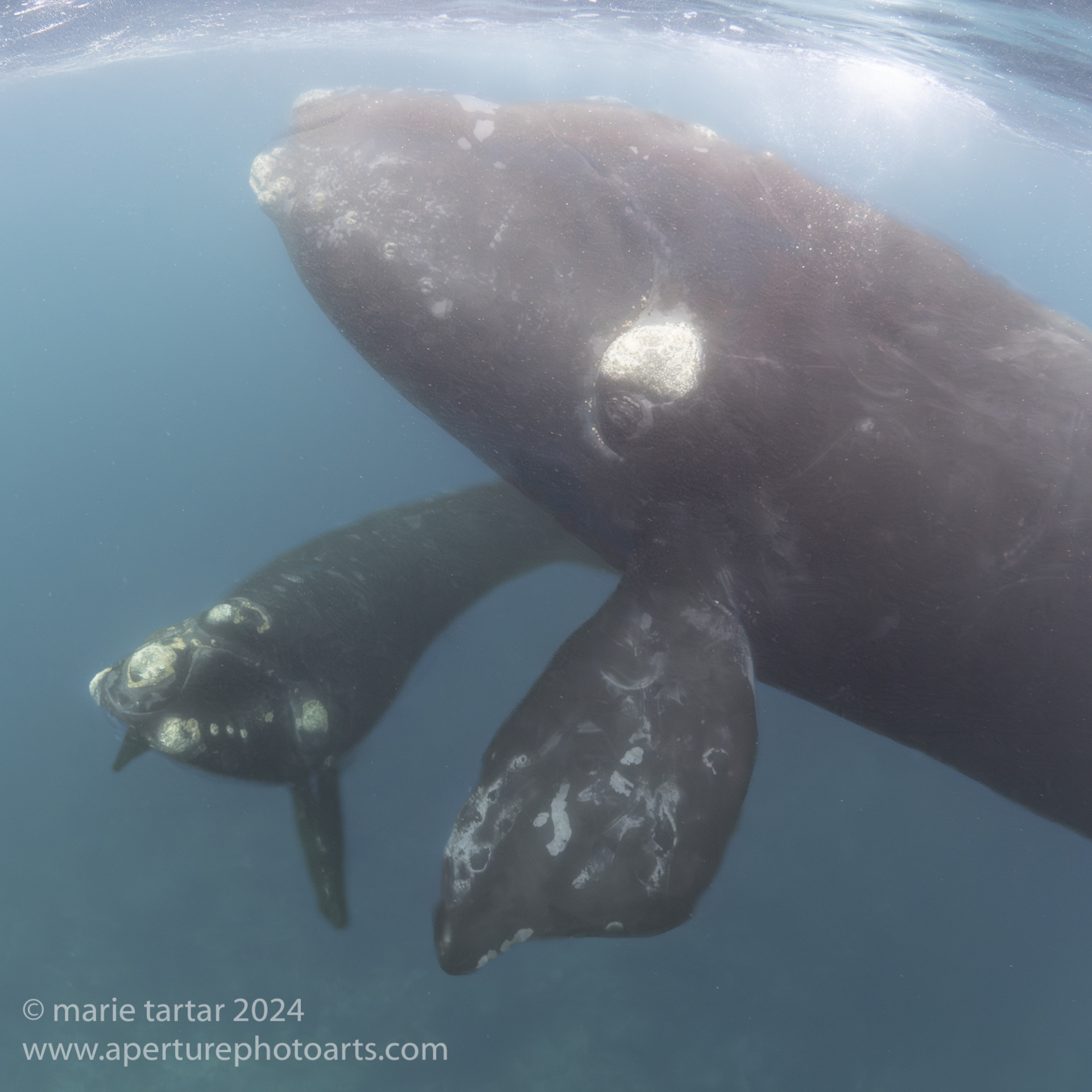
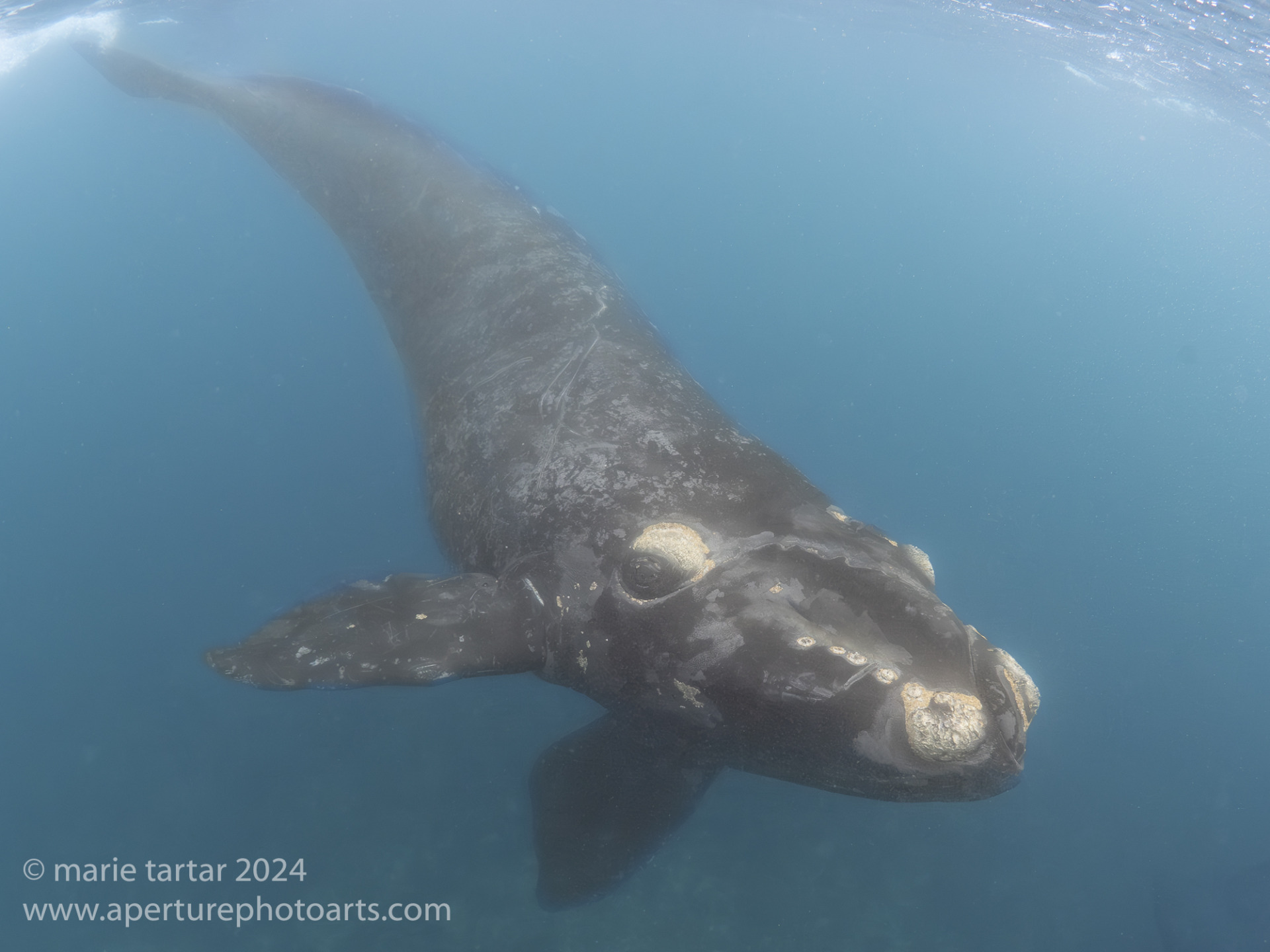
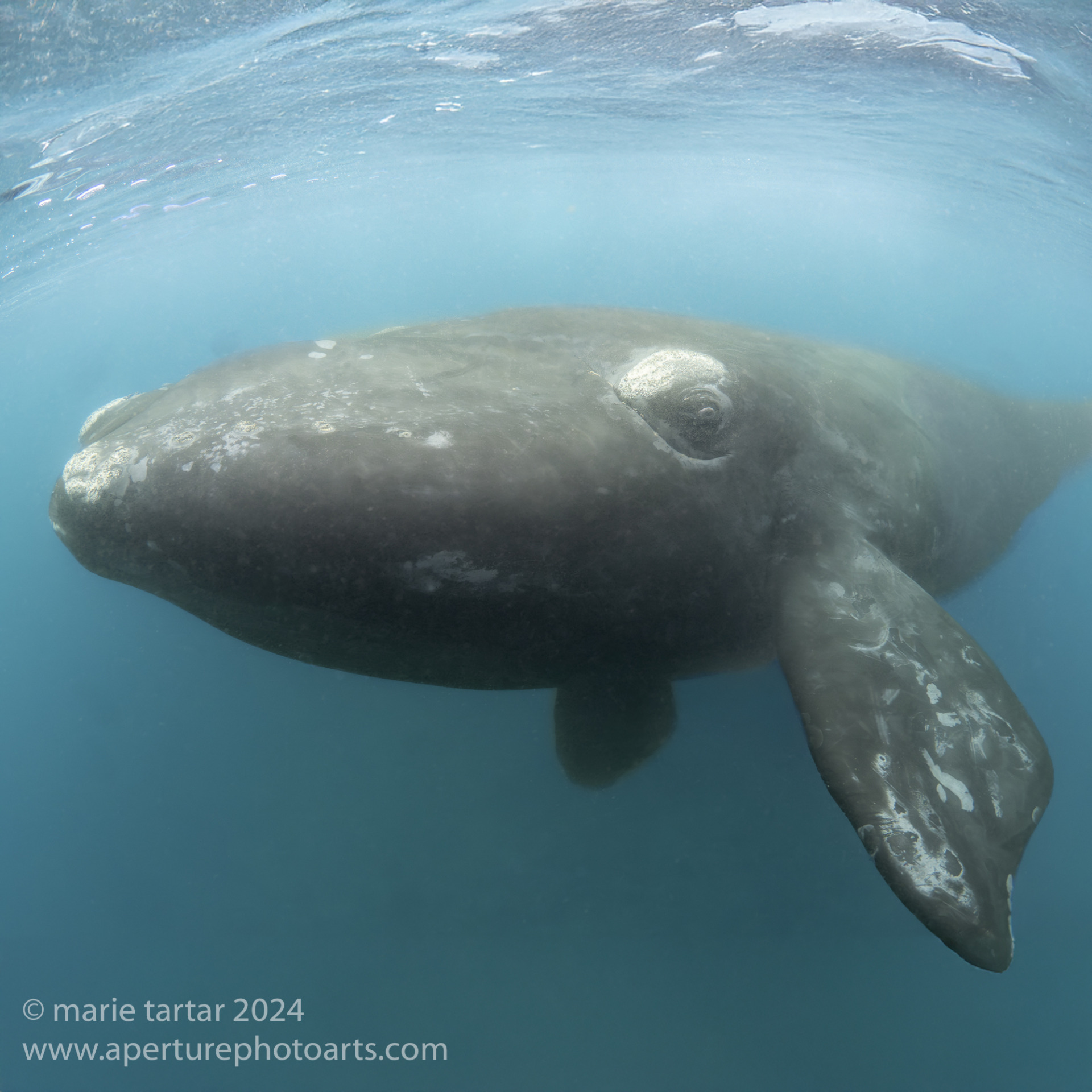
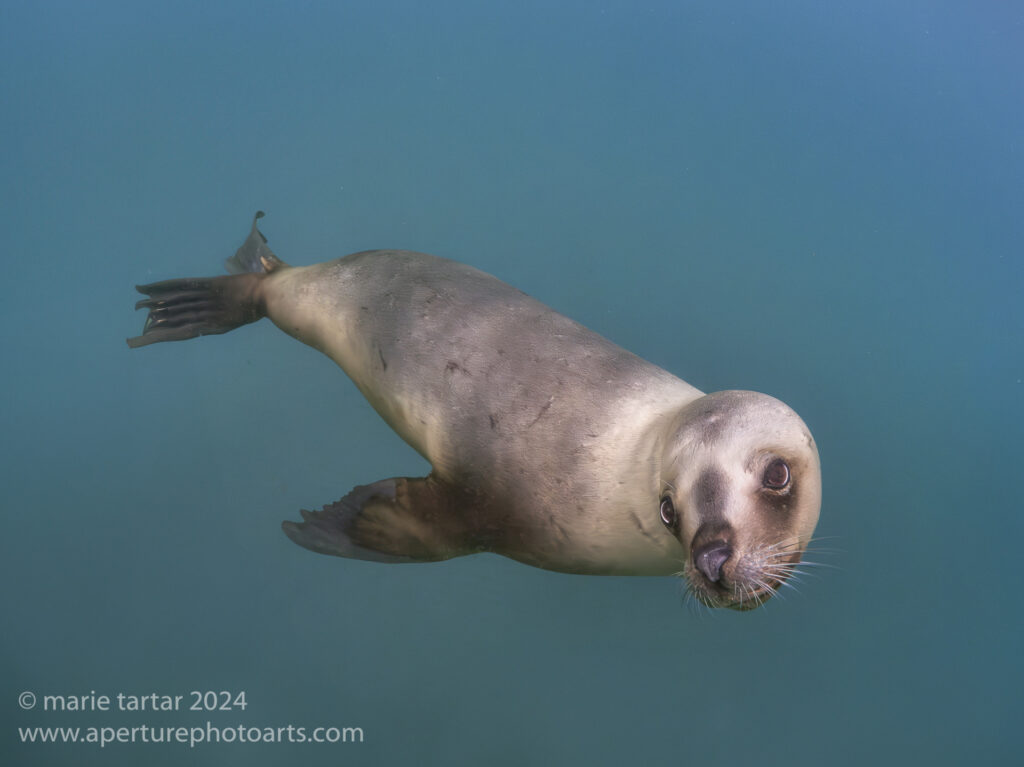
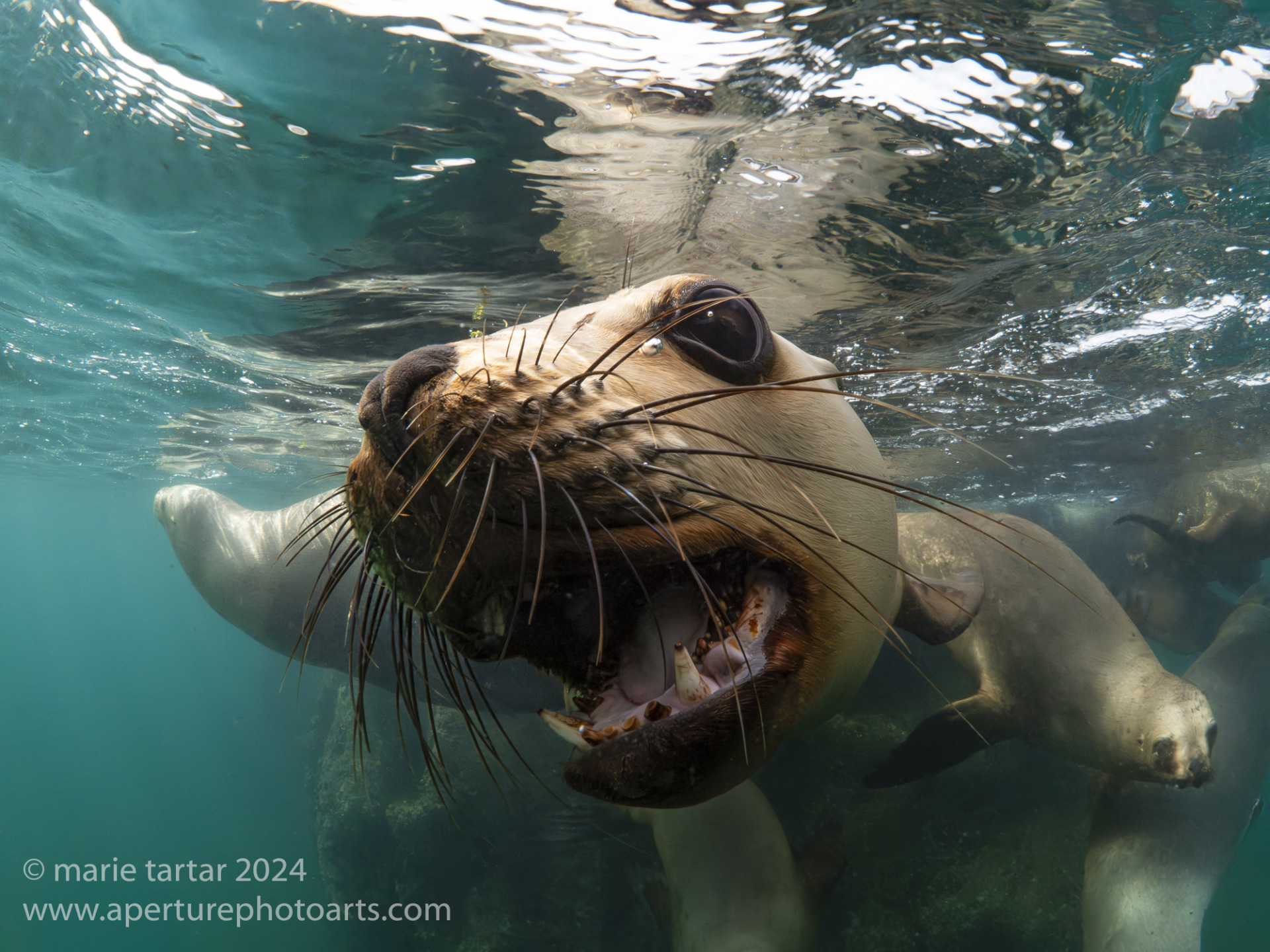
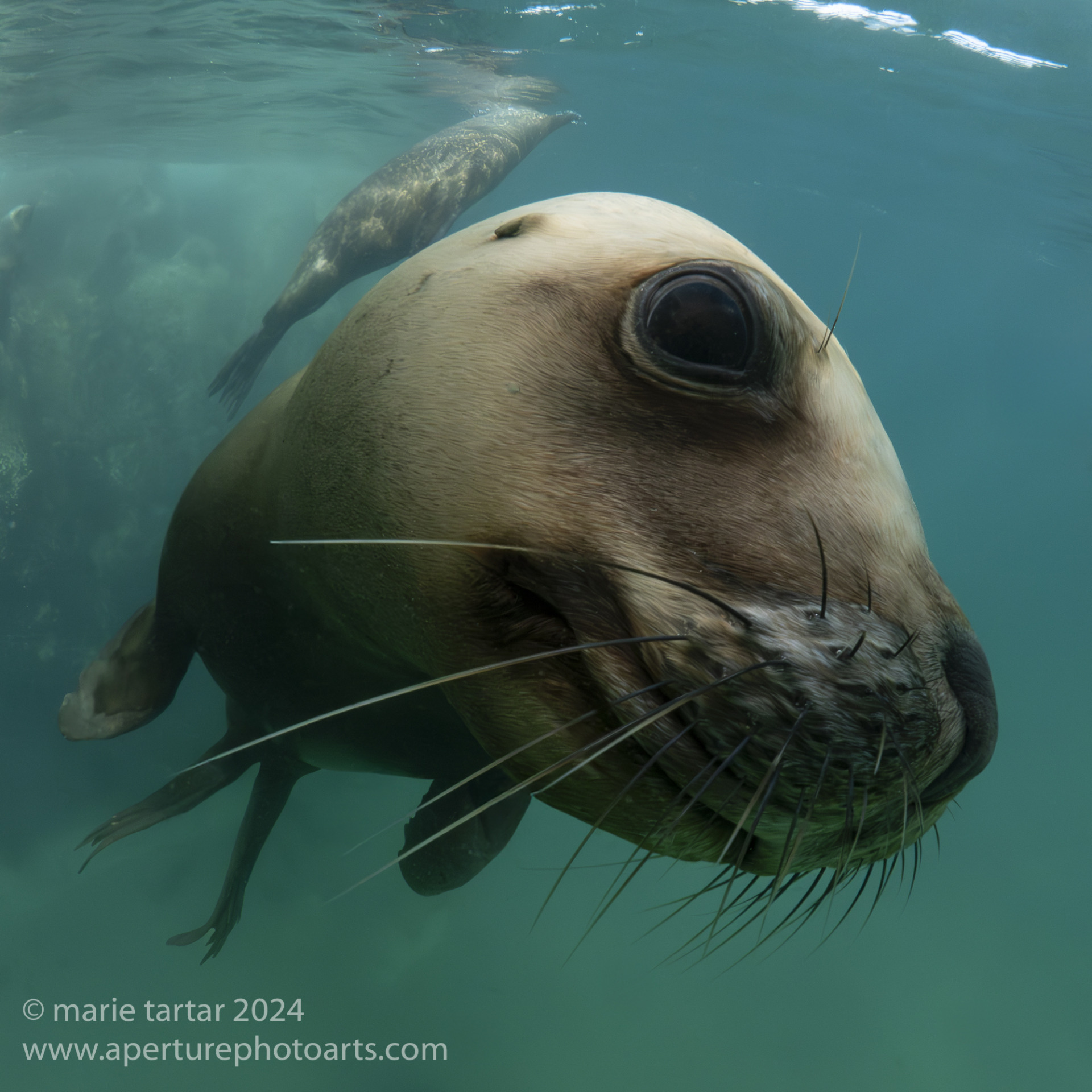

I always love your elegant prose and outrageously wonderful photos and cant wait for the next installment. Bravo!!
Thank you Donna, It was an incredible experience!
-Marie
Hi Marie,
Stunning as always.
Do you have a collection of your Buenos Aires pictures? That is on our list for next year, and I would love to see your pictures.
Alice
Hi Alice,
Yes, that is in the works.Hopefully, sometime in the next month!
-Marie